Also after thinking about it a while, I guess I'll briefly talk about the PC character classes. Again, I'm a D&D player who... cares more about the world-building and the wacky creatures and the actual optimization and min-maxing has always been pretty low on my priorities compared to something like the flavour of the dungeon or city or story. But character classes are pretty neat to cover, too!
Click here for the previous part, covering Kobolds to Mimics
Click here for the next part, covering Oozes to Sahuagin.
Click here for the index.
____________________________________
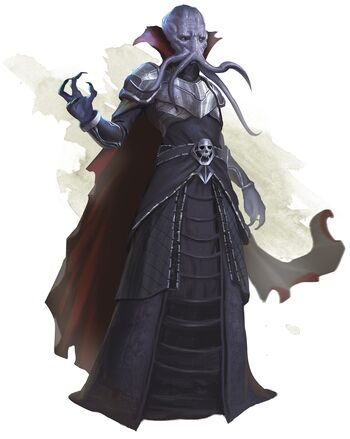

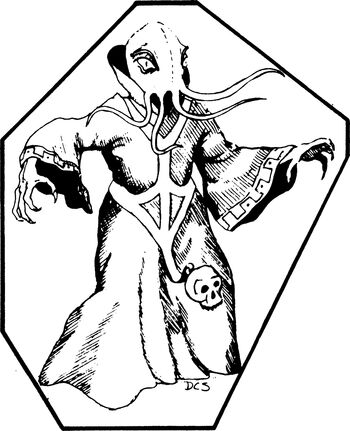
Mind Flayer / Illithid
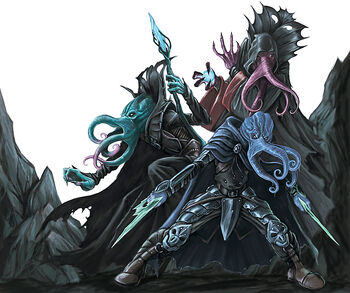 |
| Illithid (4E) |
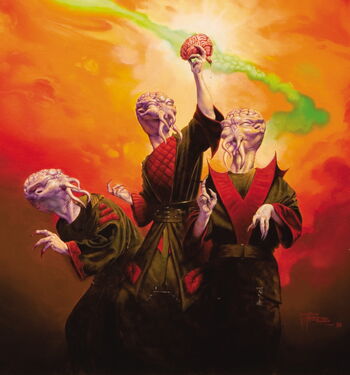 |
| Mind Flayer (2E) |
There is a lot about Mind Flayer culture. 3.5E had huge chunks of the sourcebook Lords of Madness devoted to Illithid culture, and 5E had a section of Volo's Guide to Monsters also devoted to Mind Flayers. They grow from parasitic tadpoles, just to add to the alien-ness, where they were implanted to selected hosts and eventually take over their body as their own. Honestly, there's always a campy feeling to an octopus-headed brain-eating creature that lives under the ground and dresses in fancy Gothic outfits. The Mind Flayer really does straddle the line between gloriously horrifying and goofy-but-cool. I really don't have a whole ton to say here, but I honsetly wager that the Mind Flayer has as much of a hand as its Lovecraftian inspirations in popularizing the octopus-headed humanoid as a popular culture monster.
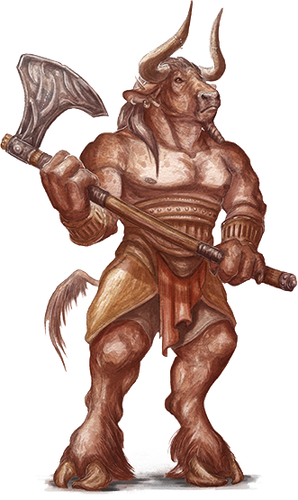
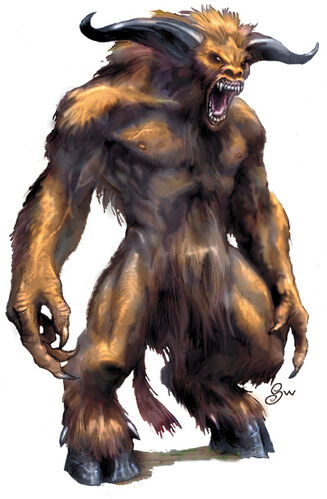
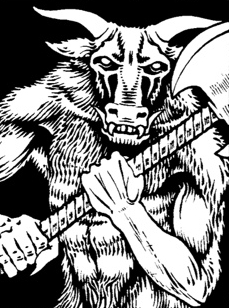
Minotaur
World of Warcraft may have really hammered home that the Tauren cow-people are a peaceful race, but D&D's Minotaur is nothing like that, instead going back to the snarling, grotesque bull-man of Greek myth. Art-wise, the 5th edition minotaur might look a lot more civil than its predecessors, but it's still described as a savage conqueror that is feared by civilized creatures. In a nod to the original myth of the Labyrinth of Crete, minotaurs are noted to particularly like dungeons and mazes with a labyrinthine or maze-like setup, born with a keen sense to navigate through mazes... all the better to smash and reduce its prey to a bloody pulp. They're just single-minded, barbaric monsters, and... and that's mostly about it. The Monster Manual sort of describes the origin of the minotaurs as being born out of demonic cults that serve the Demon Lord Baphomet, himself a giant bull-man-demon living in a layer of hell that's also a giant labyrinth. Okay! Nothing much for me to say here, the minotaurs are sure giant bull-men. Definitely a neat effort in trying to integrate some D&D-original lore while still paying homage to the original myths.
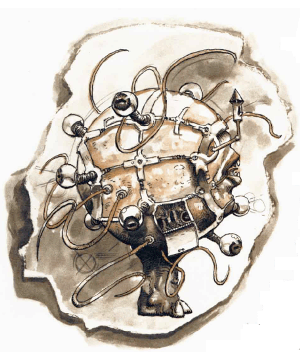
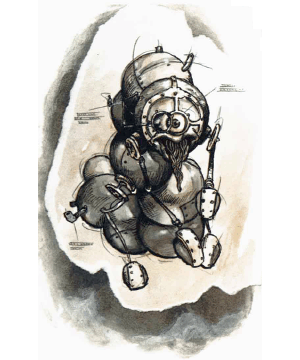
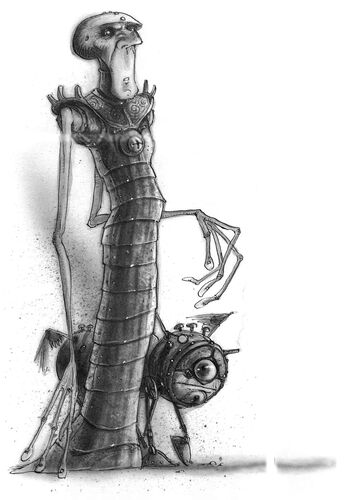
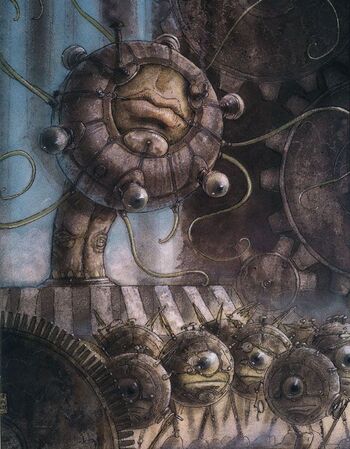
Modrons
YEAAAAH MODRONS. While the Flumphs have had a resurgence in popularity in the D&D community, the Modrons have always been one of thsoe things that seemed doomed to just be left behind in 1E and 2E, left to languish in obscurity. They were supposed to be the representatives of the Plane of Law, Mechanus (Nirvana in 1E), a tribe of robotic beings that went up from the monodrone to the duodrone upwards to things like nonaton, octon, septon and finally Primus, the god of
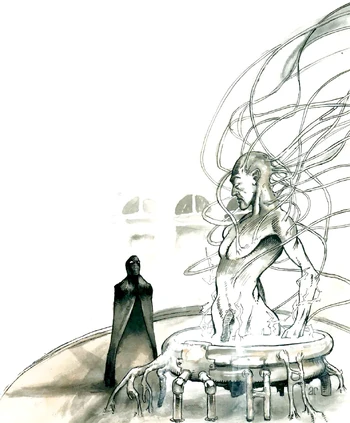 And who would've thought that the Modrons would make the mother of all comebacks in the freaking core Monster Manual in 5th Edition? Not a supplementary bestiary, not as an afternote in another guide book. The core Monster Manual. Shit, I certainly didn't expect this, for sure. Best of all, though, is that the Modrons in 5E are essentially nearly identical to how they were conceived in the 2nd Edition, these almost 80's cartoon wacky steampunk robot critters that live in a massive robotic hivemind. Where angels are good, fiends are evil and elementals are chaotic, the Modrons represent law and order, a bunch of machines that serve the law of the 'hive' and their One True Prime, Primus, as they patrol the massive plane of gears. They basically 'increase order in the multiverse in accordance with laws beyond the comprehension of mortal minds', whatever the fuck that means, but I guess they sort of maintain the laws of maths and physics? They have no ego, they have no morality, they have no real individuality, there's just what they must do. They are so orderly that they communicate with only those of equal rank, and the ranks immediately above and below them -- two gaps is too much of a gap to understand. They continue to maintain their realm of Mechanus without any real reason that us mere mortals can understand, sometimes having massive amounts of Modrons migrate out of the realm of Mechanus in what's known as the Great Modron March to do some strange things us mere mortals don't really know. It's in these migrations that adventurers meet these wacky robot people, and the MM also notes that sometimes Modrons can malfunction and go rogue, which would lead to a decidedly not lawful Modron.
And who would've thought that the Modrons would make the mother of all comebacks in the freaking core Monster Manual in 5th Edition? Not a supplementary bestiary, not as an afternote in another guide book. The core Monster Manual. Shit, I certainly didn't expect this, for sure. Best of all, though, is that the Modrons in 5E are essentially nearly identical to how they were conceived in the 2nd Edition, these almost 80's cartoon wacky steampunk robot critters that live in a massive robotic hivemind. Where angels are good, fiends are evil and elementals are chaotic, the Modrons represent law and order, a bunch of machines that serve the law of the 'hive' and their One True Prime, Primus, as they patrol the massive plane of gears. They basically 'increase order in the multiverse in accordance with laws beyond the comprehension of mortal minds', whatever the fuck that means, but I guess they sort of maintain the laws of maths and physics? They have no ego, they have no morality, they have no real individuality, there's just what they must do. They are so orderly that they communicate with only those of equal rank, and the ranks immediately above and below them -- two gaps is too much of a gap to understand. They continue to maintain their realm of Mechanus without any real reason that us mere mortals can understand, sometimes having massive amounts of Modrons migrate out of the realm of Mechanus in what's known as the Great Modron March to do some strange things us mere mortals don't really know. It's in these migrations that adventurers meet these wacky robot people, and the MM also notes that sometimes Modrons can malfunction and go rogue, which would lead to a decidedly not lawful Modron.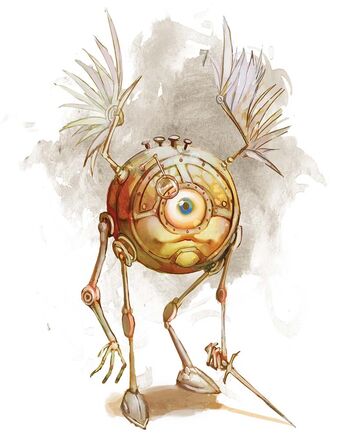
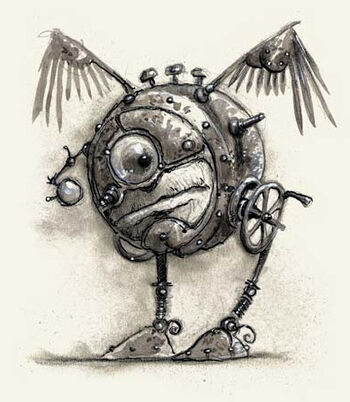
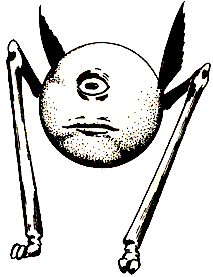
Modron: Monodrone
So the lowest of the low among the Modron race is the Monodrone. And I can see why the 1st Edition reception wasn't the best -- they were just shapes with increasing amounts of limbs and facial features that just look weird. I do find that there's a weird goofy charm about 1E's Monodrone, with its orange-like body structure and the strange way that the legs are bent, although I certainly infintitely prefer 2E and 5E's more defined Monodrones, where they have little thin limbs -- only legs for 2E, while 5E Monodrones have legs and arms and even a dinky little sword. I absolutely love the fleshy eyeball and that face that I'm not quite sure is meant to be fleshy or just very bendy metal. Love the rudimentary, almost skeletal wings, too. Either way, the modern Monodrones do really work as the 'mascot' of the race, looking clumsy and weird enough to retain the original charm of wacky steampunk critters. It's even got a little monocle attached to the side of its head! Adorable.
I do really love just how the description of the Monodrone emphasizes that it can only do a single task at any time, and it can only relay a message of 48 words. Such specificity for these wacky robots!
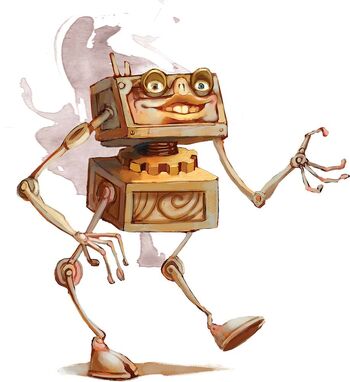
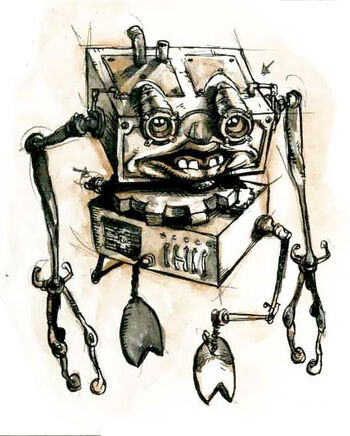
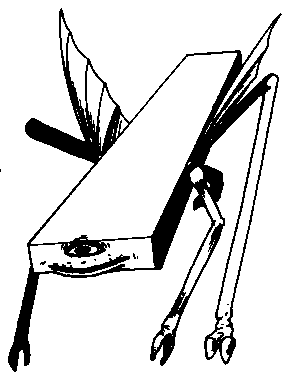
Modron: Duodrone
Now as the drones rank up, they get a bit more complex. For the Duodrone, they went from being a sphere to a thing with extra edges -- a long rectangle with bug legs in 1E, and the significantly more interesting two-squares-connected-with-each-other-with-a-gear in 2E and 5E. I absolutely love how they kept the grotesque lips from the 2E artwork, and even though 5E certainly makes an effort to make these things look friendlier, I do really love just how alien they still look on account on being a bunch of blocks with little spindly arms and a bizarrely humanoid nose and mouth attached to it.
The Duodrones look pretty neat, and they can perform two whole tasks at a time. They're barely better than Monodrones, though, as far as communicating with more intelligent (or, well, I guess less robotic or restricted) beings go. Admittedly, we did lose the progression from "sphere" to "flat surface" to "triangle" to "square", but I do really love the new version of the Duodrone so much visually.
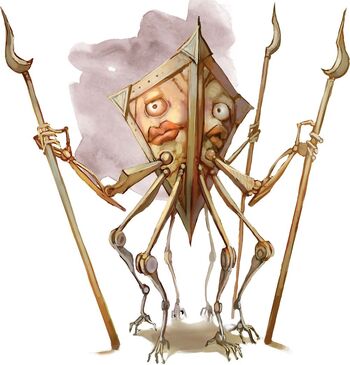
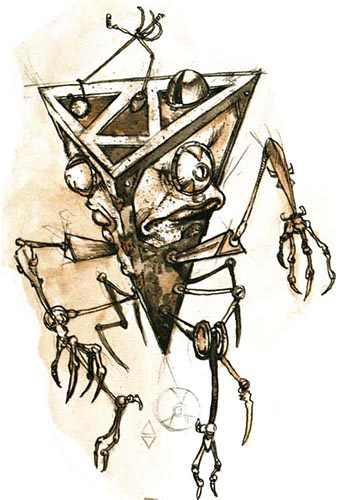
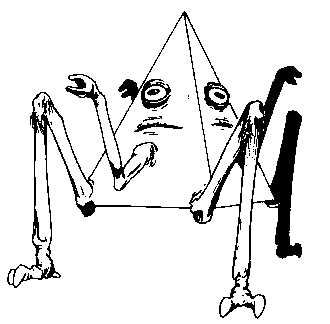
Modron: Tridrone
And as we go up, we reach perhaps one of my favourite designs. The original 1E Tridrone looks like a weird Illuminati triangle monster, just a pyramid with a bunch of crab legs and facial features, but I absolutely love the 2E and 5E Tridrone. Making the pyramid inverted and much more tapering, and slapping a clearly stern face with full lips on each side of the pyramid is such an interesting visual design, and that's before you get into the mass of spidery legs and an arm, each holding a glaive of sorts. The Tridrones are perhaps the first real 'supervisor' unit that keep the Duodrones in line.
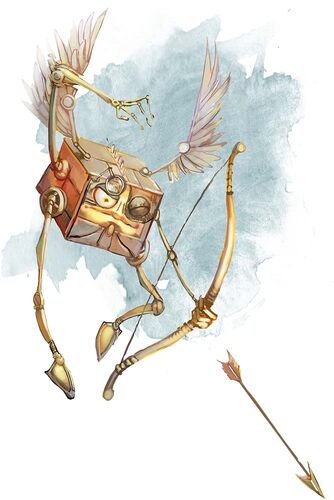
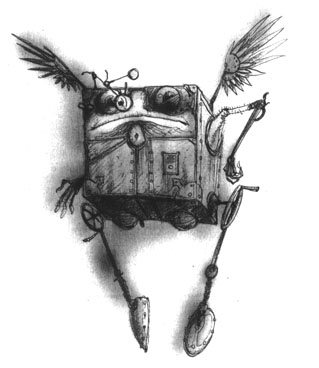
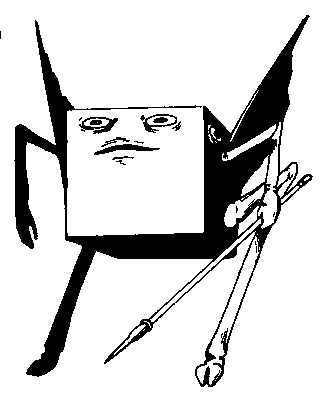
Modron: Quadrone
The Quadrone, of course, is a square. 1E's Quadrone just sort of looks crazy, but it's amazing what a bit of additional details can manage to do, yeah? I absolutely love the almost suit-like markings on the lower half of a Quadrone's face, the monocle that returns from the Monodrone and the Cupid-like pose that the 4th-edition Quadrone takes. The Quadrons take a ranged, artillery role in Modron society, acting essentially as field commanders. I do kinda feel like the Quadrone perhaps feels a little less complex than the Duodrone and Tridrone, though, and maybe it would've worked better if they've been swapped around a little? Still, a pretty neat design, and who am I to argue with the heirarchy and increasing complexities of the mechanical race of geometric robots?
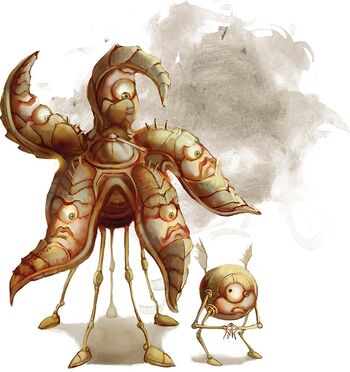
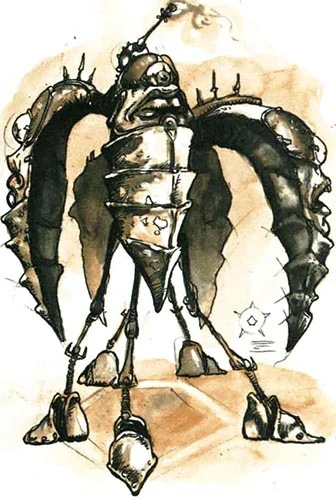

Modron: Pentadrone
While 1E and 2E had many, many more 'greater' Modrons, the 5th Edition stops at Modron #5, the Pentadrone, the most advanced of the 'base' Modrons before we move up to the hierarchs. They are so advanced, they can do five tasks at once! I do really like the 5th Edition artwork, which has the five starfish-like tentacles of the Pentadrone, and their disapproving, full-lip faces, glare down at one sheepish Monodrone. Keep in mind that neither Monodrone nor Pentadrone can actually communicate to each other thanks to how Modron interaction works. I really do love just how fun the lips look on these silly monster. Oh, and made the most apparent in the 1E artwork is that the little dome at the center of the Pentadrone is actually a flamethrowing tank turret. Okay!
There's certainly a bit of a War of the Worlds walker style vibe to the Pentadrone, what with its many stilt-like legs, but I do really like just how funky it looks, and how unique the starfish-robot-on-spider-legs look ended up looking. That's it for the Modrons in 5th Edition, and while it's a shame that we don't quite get too much in terms of lore about these bizarre, unique geometry robots, I do hold out faith that at some point in the future, we might get a module or two that focuses a lot more about the Modrons.
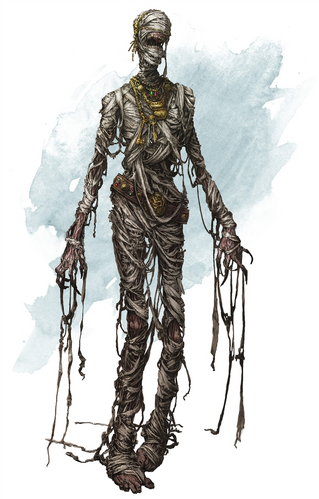
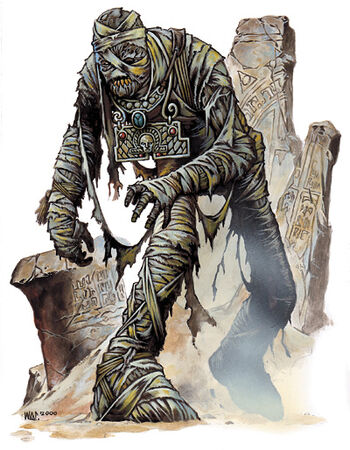
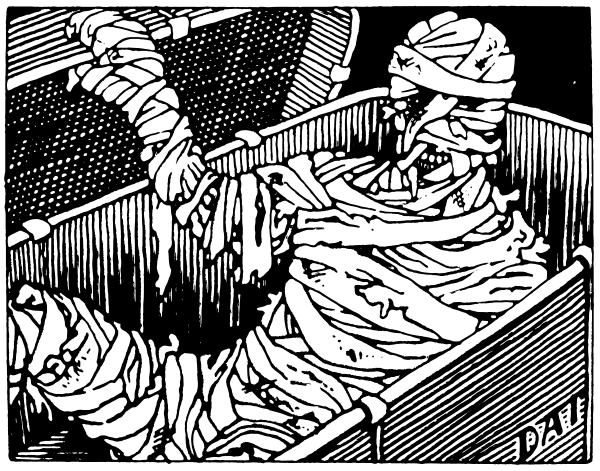
Mummy
Another classic halloween-y undead trope is the mummy, based on the same sort of funerary dead in Egyptian culture. Thanks to me playing a lot of Legend of Zelda games in my youth, I've always sort of internalized fantasy-genre mummies as being slightly fancier zombies. In D&D, on the other hand, mummies are solidly in the middle-to-upper tier of undead monsters, slightly below the actual big bosses like the liches, vampires and death knights. Multiple editions also tended to include some sort of a Mummy Lord, to hammer home that these bandage-covered shambling dead are supposed to be pretty mighty adversaries. I do like that a fair bit, and mummies tend to not just be powerful undead warriors and sorcerers, but a lot of their flavour in combat comes from their ability to cast curses, a nod to the urban myth of Tutankhamun's Curse. The Mummy Lord is essentially something akin to a Lich, an undead that retains the identity, memories and abilities it had in life, and the flavour is that these ancient kings and queens are buried in a massive tomb with an entire contigent of dark sorcerers and warriors, waiting for the time to return to the outside world. The canopic jars end up becoming the mummy lord's equivalent of a phylactery, and they'll reform from the dust next to the jars.
Mummies are not always evil or sentient, either -- they're created with a god-of-death ritual, and some of the lesser mummies are just corpses infused with orders to rise up and attack any trespassers or intruders to their ruler's tomb, making them quasi-golems in a sense. Depending on the trigger for the mummy's awakening, doing something like placing the idol back or resealing the entrance of a tomb might sometimes be enough to 'deactivate' the mummy, but tough luck if you did something irreversible. Also, mummies carry the Mummy's Rot, a disease that causes a victim's body to slowly rot and decay, just to add an extra dimension of "oh shit you shouldn't have fucked with King Tut's tomb" into the whole deal. Overall, while I didn't expect much from mummies, I do really like that they tried a fair bit over the various editions to really make them pretty dang cool, and easily ripe to be antagonists of a setting.
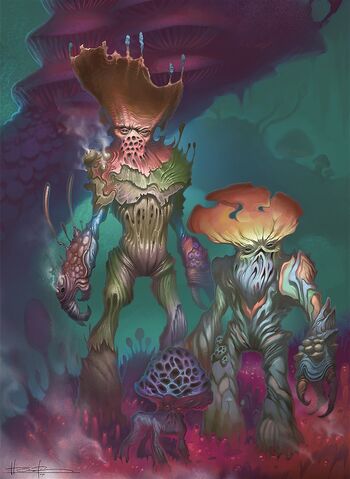

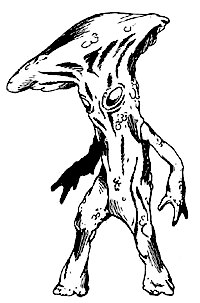
Myconid
YES THE MYCONIDS. Y'know, I've got a lot of favourite creatures in D&D. The Kuo-toa, the Kenku, the Mind-Flayers, the Beholders, the Thri-kreen, the Yuan-ti, even some more obscure critters like the Nothic, the Ettercaps and the Ankheg. But honestly, not a lot of them offer much competition in my heart as the Myconids do. What they are is honestly relatively simple. They're mushroom-men! D&D has made a living career of taking any available animal, slapping some legs and arms onto it and calling it a day. And doing the same thing with mushrooms really shouldn't be all that different. But it is. Over the various editions and years, the Myconids (originally the "Fungus Folk") have developed a pretty unique identity not just as a bunch of funny mushroom people, but as a genuinely interesting society that lives in the Underdark, within massive, gigantic fungal forests. And, honestly? The descriptions and artworks made of the Myconids' civilization is perhaps worth the entrance fee, and that's without going into the Myconids themselves. There's just something so utterly alien about mushrooms and fungi in general, yet so natural, that looking at these beautiful-yet-alien fungal designs is always something that makes me really love these buggers.
What's perhaps most interesting about the Myconids is that despite looking like they should be monsters -- fungi tended to be associated with poison and rot, after all -- they're actually very much neutral, which is very rare for Underdark races. Most of everything in the Underdark tended to want to murder any sentient being that comes across them! They distrust outsiders very much, but they tend to not be hostile, because they seek enlightenment, and unless unavoidable, will try to not get violent at all. And when they do, they tend to just rely on fists, primitive fungal-based weaponry, or by weaponized spore. Which is probably like the fungal equivalent to either babies or sperm cells. Best not to think too much about it. A lot of what I remember from them is a combination of the 3.5E bestiaries and their Underdark sourcebook, but 5E does give a new spin instead of just regurgitating old material.
Myconid structure revolves around the greatest and largest Myconid in a Circle, called the Myconid Sovereign, a concept that I think is only introduced in the 5th Edition. The Sovereign basically leads the Circle in a commune known as melding, allowing the Myconids to merge their primitive fungal minds and essentially enter a hive-mind that allows them to share information and consciousness, basically these strange fungal people's method of social interaction, and this bizarre bit is why they are so peaceful as a whole, since disharmony is something that they stamp out through this mind-meld. This is apparently the 'purpose' of their existence, and collective union is what they strive for. Most interestingly, how they communicate with other sentient creatures is with 'rapport spores', so what's essentially little baby fungi are implanting themselves within any humanoid they communicate with just to open a telepathic channel to the Myconid Circle's hive-mind.
While they're benign, the Myconids are still fungal people and they do have some creepy abilities. From 4E onwards, we've been having Myconids with various features taken from various real-life mushrooms instead of just a toadstool, and I do like that 4E artwork with two burly Myconids with spiky gauntlet-like arms, that somewhat wizard-like dude with gangly arms, and the phallic-headed leader in the background. 4E has always been the edition that goes way too overboard with listing like five or eight different variations of each race, but for the Myconids, it's one of the few where the stark variation feels actually appropriate considering how different the Myconid sub-types look in the artwork.The artwork for 5E also shows us two very distinct-looking mushroom dudes based on different mushrooms, and... and is that a brain-fungus Myconid dog in front of them? For 5th Edition, it's mostly just regular Myconids and the Myconid Sovereign, which comes with the ability to create Spore Servants, which is sort of a unique method of necromancy-via-spores... Pretty cool stuff! Again, it's something that I draw from the Myconids' portrayal in previous editions, but while most circles and colonies are peaceful, some Myconids do either go on a very expansionist bent and they just consume and expand more and more throughout the Underdark, or they get corrupted by some malign force (to use a canon D&D villain, Zuggtmoy the fungal-themed Demon Lord would probably work) and instead of being big lumbering mushroom bros, they become angry zombie-making mushroom bros. Honestly, the Myconids are pretty damn cool.
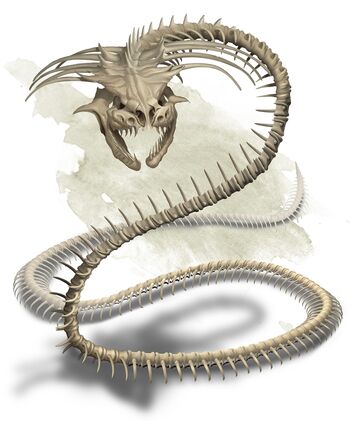
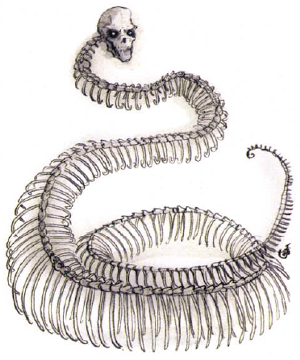
Naga: Bone Naga
Taking their name from a race of mystical, divine serpents from various Hindu, Buddhist and Southeast-Asian cultures, D&D's Nagas are just straight-up sentient serpents with human faces. I'm always a bit iffy about them just borrowing random names from active religions because they sound exotic, but with the Naga, D&D's take has sort of gone back and forth on just how close of an adaptation of the actual Hindu/Buddhist beings, with a lot of argument on whether they should be closer to the source material or be as far apart as possible.
Just how human the Nagas' faces, like the manticore, depends on the art direction for the particular edition, with 5E going for the Naga's faces having humanoid features, but not quite as uncanny-valley as 1E or 3E's art. The flavour for the Naga as a whole is that they're created as immortal guardians by some bygone ancient culture (there are a lot of ancient cultures in fantasy, huh). Immune to aging and sickness, and when struck down, their spirit reforms in a new body. The Nagas have ended up declaring themselves the master of the ruins of their masters' civilization, and while not quite as aggressive as some other races, their culture essentially revolves aroud guarding and acquiring information and magical artifacts. How benign or tyrannical they are is up to the individual, but Nagas basically really love to act as the supreme rulers of their domains.
The Naga always come in many different flavours, and the first we're going to talk about is the Bone Naga... which is probably not the best one to really start of with, actually. The Bone Naga is essentially an undead Naga, which looks pretty damn cool. But the Bone Naga is a shell of what a Naga should be, having been transformed with a necromantic ritual by the Yuan-ti into a skeletal servant without much memory of the spells it knew in life. The Naga and the Yuan-ti apparently have a huge beef, and are rival races. I do find Bone Nagas to be cool. 5E's artwork leans a bit too much towards it just being a snake skeleton with the upper half of a human skull merged with snake jaw bones, though -- I really like the odd look of the original 2E artwork with the long, tapering human rib bones, or the far crazier-looking jagged mass of bones from 3E.
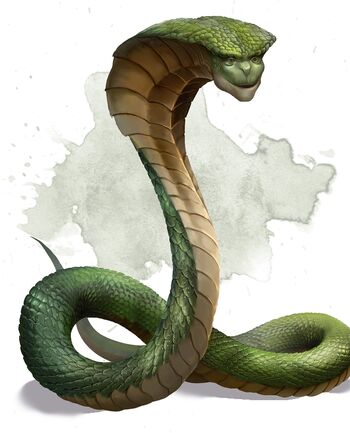
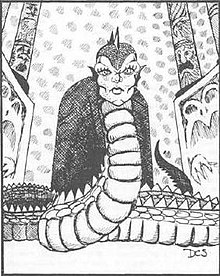
Naga: Guardian Naga
The next couple of Nagas are the more 'basic' Nagas. Guardian Nagas are lawful good, and tended to look a lot less sinister than their brethren. Well, as non-sinister as a serpent with a human face can be, anyway. They protect the sacred tombs and reliquaries, and stop items of magical power from falling into evil hands. They stay in their lairs and basically just stay and plan for "convoluted plans" to stop evil. So, like, they're the reverse-version of a typical superhero villain, then?
Guardian nagas are mostly just there as either NPC allies or quest givers, but a pretty flavourful one. Or, if your GM is anything like mine, set up a misunderstanding where the Naga thinks your party is trying to plunder its lair while the party is like "holy crap snake monster!" While they're not the most dangerous enemy out there, but their nature means that they will keep coming back again and again, something that, according to the Monster Manual, can only be undone by the mighty wish spell. Which means that you'll probably have to get creative in dispatching the nagas you face. You can probably negotiate with a Guardian Naga, but, of course...
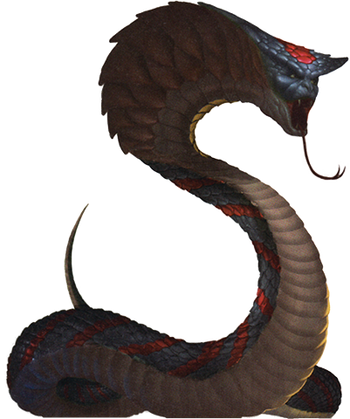

Naga: Spirit Naga
There's the evil member of the bunch. I'm not sure which I like more, the utterly bizzare and tortured looking 3rd edition artwork with a wretched, ragged-hair human head plastered on an oddly bent snake body, or the simply cool-looking giant cobra creature from 5E. Either way, the Spirit Naga are the evil representatives of the naga, lurking in dark dungeons and enslaving those who have wronged them with their mind-domination powers. They continually plot revenge against those who wronged them, and the fact that they keep coming back to life is definitely a problem... you can't kill it permanently with fireballs and swords, and there isn't even the option of "well, gotta make a side trip to hell to kill that one pit fiend!" So your party needs to get a bit creative. Imprisonment? Sic a yuan-ti tribe to turn it into a bone naga? Teleportation to a different continent? Toss it into another plane and make it the Abyss or the Feywild's problem? (I don't recommend that last one, lest you want a recurring naga returning with warlock abilities)
Anyway... nagas are pretty cool. Definitely underused, and one I've never really paid too much attention at until my GM threw one at me, but pretty cool.
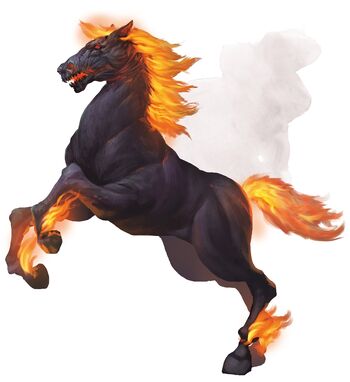
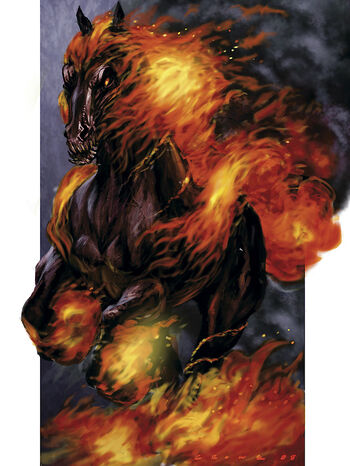
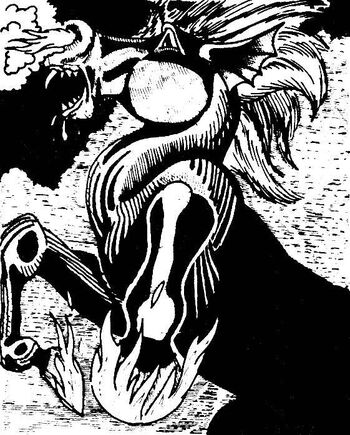
Nightmare
Horses always have this pretty dang cool association in our minds, particularly in Middle Ages inspired settings like what D&D, at its core, is meant to represent. And horseback riding is a huge point in these settings, which led to a lot of horse-based mythological creatures like pegasi, unicorns, centaurs and hippogriffs... all relatively heroic equine creatures. But what about all the edgy death knights and legion devils that want to ride around horses like all the cool kids? What about the evil riders like the Ring Wraiths or the Headless Horsemen? Well, you have the Nightmare, a burning, shadowy hell horse of doom. And honestly... it took me way too long before I got the pun in this critter's name.
Nightmares are supernatural demon horses that basically only allow creatures of evil to ride them. They're sentient, and they are summoned from the lower planes. And they require a sacrifice, otherwise, like all domesticated animals, they will refuse to obey orders. The origin story for the Nightmares is that they are pegasi that are captured, tortured and transformed through foul magics to become the insane fiend entities that are the Nightmares. Absolutely love the demonic bony fangs they have from 4E onwards.
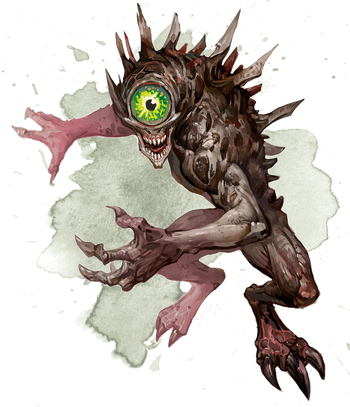
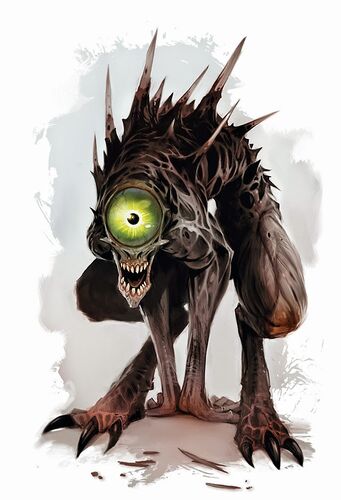
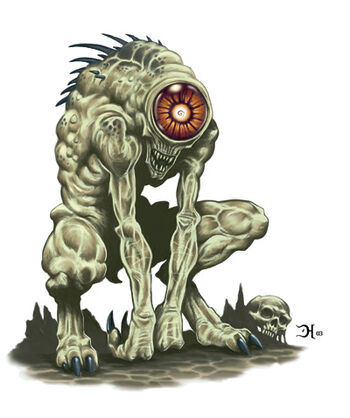
Nothic
The Nothic is a critter introduced in 3E that I've sort of glossed over and written off as "weird, creepy cyclops ghoul" in my head for the longest time. I mean, it's neat for sure, and the 3E artwork with the gaunt pose and the bizarre head anatomy and that perfect crazed look on the Nothic's face, but I've never really paid it much attention. There were too many weird things in 3.5E's bestiaries that the Nothic just sort of fell by the wayside. While there was certainly something interesting in them, mechanically, flavour-wise they were just one of many random aberrations from the Far Realm, and look positively mundane after you get past their "man, what a weird ghoul-like creature" bit.
And... well, the Nothic instantly became one of my new favourites when my current gaming group bought the 5E starter set, and the small campaign that we tried out within had a Nothic for one of its encounters in a room. And it's this specific encounter that ended with me walking away and considering the Nothic as a pretty dang cool creature. It behaves so strangely, just content to lurk in the dark and just watch with that massive eye and a grin, using its gaze to somehow rot the flesh of random humanoids that wander a bit too close. The backstory is that they are wizards who end up accidentally peering too much in all that search for ultimate power, and accidentally gets exposed to a curse left behind by one of D&D's recurring big bads, the lich-god of secrets Vecna, and they get turned into one-eyed gibbering monstrosities. They retain none of their past personality, but are tortured with the knowledge that there is a method to reverse their condition... even if they don't even remember what, exactly, is wrong with them. Since they were cursed by a godlike being of secrets, this means that despite their insanity and their lack of comprehension, they're able to know a whole lot of secrets, like some sort of crazy, twisted seer or oracle. And just by looking at your characters, the Nothic will slowly gain some random trivia and insight about them. And this little blurb in the 5th Edition's Monster Manual ends up turning the Nothic from just a weird gangly cyclops-ghoul into such an interesting creature, someone who's seeking knowledge due to some vague nagging at the back of their mind, a creature who ends up knowing and learning about information simply by sight... That's honestly pretty cool, and I genuinely wished that more adventures utilized Nothics more, maybe as NPC's or a creature you could persuade to help out with giving you some sort of information or something.
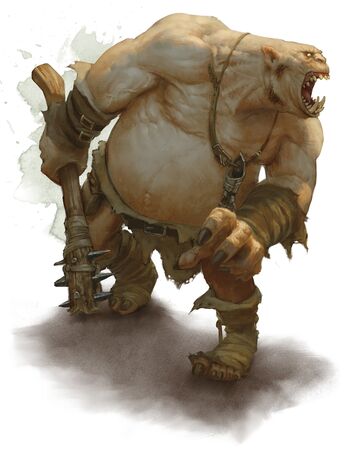
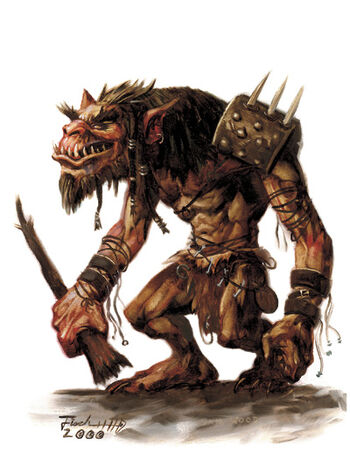
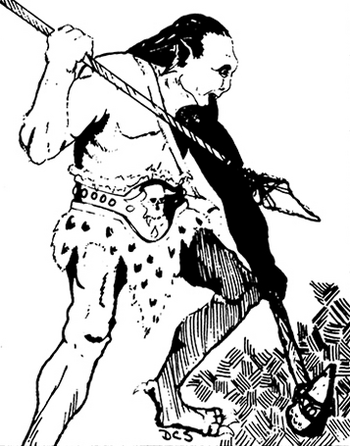
Ogre
Ogres are one of those monster names like "troll" and "giant" that just vaguely translate into a big, burly, savage humanoid, something that I've mentioned multiple times have never really appealed to me. Even among D&D, I've always found the ogres to be the most boring of the various giants -- the true giants at least had the whole lore about them being progenitor races, and trolls tended to have a lot more variation in their kind to make them a bit more interesting. And the goliaths have basically taken over the little niche of "civilized giants". Which leaves the ogres kinda just there as a simple hulking brute of an enemy. They don't even really have a consistent look being some sort of giant humanoid, with 2E and 3E going for hairy and somewhat ape-like, while 4E and 5E go for rotund and burly, sort of like a cyclops. Ogres are big, they get angry easily, they are dumb, they are greedy and they eat humanoids. I really don't have much to say here, and feel like many other giant-style enemies in D&D have so, so much more personality than the genuinely basic ogre. They're neat as
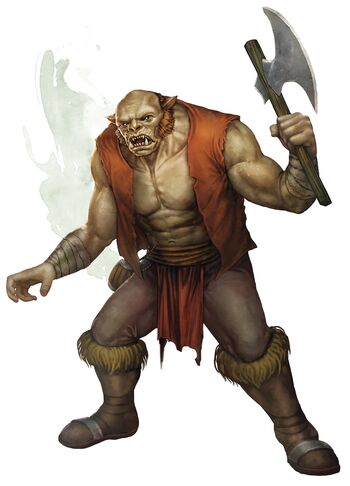
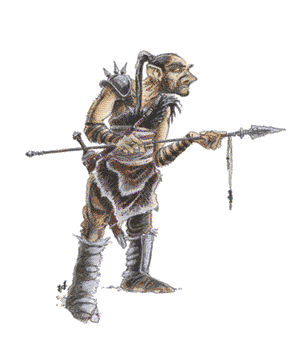
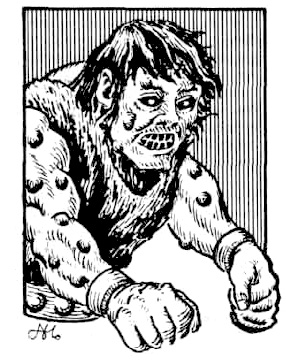
Half-Ogre/Ogrillon
The 5E Monster Maunal also lists a stat block for Half-Ogres or Ogrillons. In previous editions, Ogrillon was a specific type of Half-Ogre that bred with a Half-Orc. (Warcraft's Mok'nathal race is basically the Ogrillons with a new name) Ultimately, though, other than the rather... questionable way that the breeding happens, the Half-Ogres and Ogrillons are basically slightly smarter than their full-blooded ogre parents. They're more likely to be civilized, but, y'know, still ogre. 5E notes that only human, orc, bugbear or hobgoblin pairings can provide half-ogres, while the ogres will eat other races. Okay.

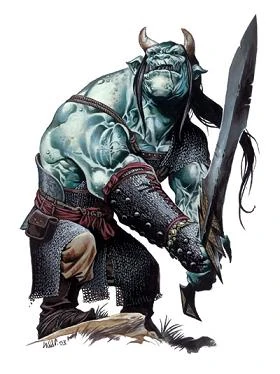
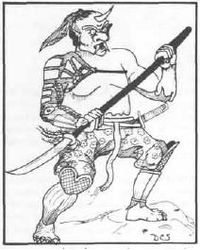
Oni (Ogre Mage / Oni Mage)
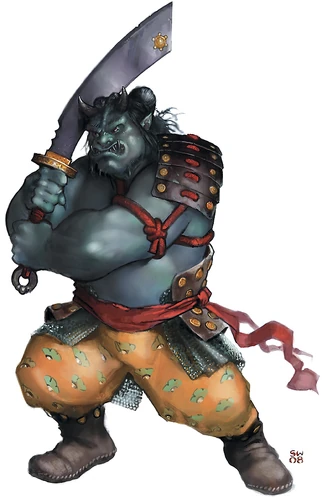 A lot of the creatures in the older sourebooks tended to draw from Eastern myths as much as they do Greek, European or Egyptian myths, but sometimes there's this weird bit where they're clearly adapting a creature from Eastern legend (like the gold dragon!) but then end up changing it into something more... localized. One example would be the Oni, from Japanese culture, who for the longest time flip-flopped between being called an 'ogre mage' or an 'oni mage' or any combination of those. And, again, just how much they draw from the depictions of oni in Japanese culture, and how much they're just boring ol' ogres with mystical abilities, tend to vary from edition to edition. 5th edition... goes for a slightly more original style, making the oni look more like a supernatural bogeyman instead of the "horned ogre-men with weapons" that they looked like in the past. I'm genuinely not sure which I prefer -- although my favourite Oni artwork has to be the Night Haunt variant from 4th edition. 5E, as usual, tries its best to take the original 1st edition Ogre Mage and build from there, adding inspiration from the 2E through 4E.
A lot of the creatures in the older sourebooks tended to draw from Eastern myths as much as they do Greek, European or Egyptian myths, but sometimes there's this weird bit where they're clearly adapting a creature from Eastern legend (like the gold dragon!) but then end up changing it into something more... localized. One example would be the Oni, from Japanese culture, who for the longest time flip-flopped between being called an 'ogre mage' or an 'oni mage' or any combination of those. And, again, just how much they draw from the depictions of oni in Japanese culture, and how much they're just boring ol' ogres with mystical abilities, tend to vary from edition to edition. 5th edition... goes for a slightly more original style, making the oni look more like a supernatural bogeyman instead of the "horned ogre-men with weapons" that they looked like in the past. I'm genuinely not sure which I prefer -- although my favourite Oni artwork has to be the Night Haunt variant from 4th edition. 5E, as usual, tries its best to take the original 1st edition Ogre Mage and build from there, adding inspiration from the 2E through 4E.
The 5E oni is noted to be fearsome creatures of the night that stalk forests and villages to kidnap children and feast on them, something that certain yokai and oni in Japanese myths like the Tengu and Yama-uba are known to do. Being big blue giants, the oni are able to use their spellcasting abilities (they're ogre mages, after all) to transform into mist, or even smaller forms. They also tend to hide during the day, pretending to be travelers or simple passers-by, upon which they infiltrate a town and befriend its 'mark', the very people it'll try to snack on. It's honestly probably not the best and most comprehensive adaptation of oni in general into a fantasy game. It's kinda neat that D&D Onis have sort of their unique spin to them, which takes the original concept of Japanese onis and adapting some facets of it, but I also kinda wished that they had done more, y'know?
PC Classes:
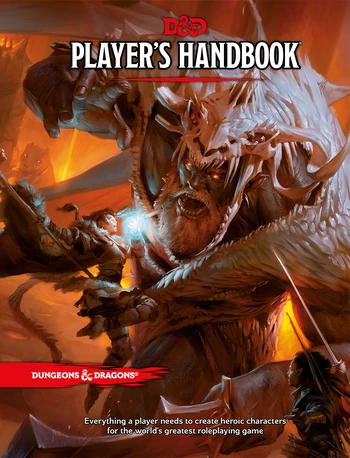 This is a bit of a quick rundown of the 5E base classes, as covered in the 5th Edition Player's Handbook. Perhaps even more than the portrayal of any specific facet or monster or setting in the D&D world, the most variable thing between editions is the combat system as well as how these individual player classes actually work. Originally, in the 1st Edition D&D, there were three classes -- fighter, wizard and priest, and that expanded to include a lot of other new classes, prestige classes and sub-classes. AD&D 1st Edition gave us Bard, Cleric, Monk, Thief, Fighter and Magic-User as the basic classes. 3E and 3.5E went particularly crazy with prestige classes, but things were scaled down in 4E and 5E, with the former adopting a far more video game-y division, while 5th Edition, like its monster selection, acted more of a 'best of' adaptation of the four previous editions, taking the most popular classes and sub-classes from the previous four editions and presenting them as the new 'base' character classes.
This is a bit of a quick rundown of the 5E base classes, as covered in the 5th Edition Player's Handbook. Perhaps even more than the portrayal of any specific facet or monster or setting in the D&D world, the most variable thing between editions is the combat system as well as how these individual player classes actually work. Originally, in the 1st Edition D&D, there were three classes -- fighter, wizard and priest, and that expanded to include a lot of other new classes, prestige classes and sub-classes. AD&D 1st Edition gave us Bard, Cleric, Monk, Thief, Fighter and Magic-User as the basic classes. 3E and 3.5E went particularly crazy with prestige classes, but things were scaled down in 4E and 5E, with the former adopting a far more video game-y division, while 5th Edition, like its monster selection, acted more of a 'best of' adaptation of the four previous editions, taking the most popular classes and sub-classes from the previous four editions and presenting them as the new 'base' character classes.
The classes are frequently updated with balance patches, new 'paths' and new lore in subsequent manuals and whatnot, but for the purposes of this review, I'm just going to touch them as they are shown to us in the 5th Edition Player's Handbook. The original draft of this article had me go through the flavours of each and every new class path, and it ended up being so overly bloated, so I ended up trimming it down to the ones covered in the Player's Handbook ones.
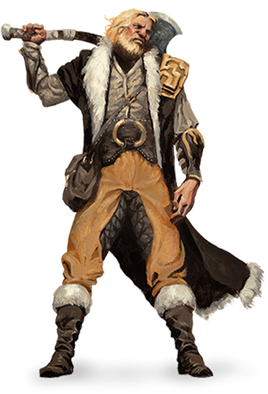
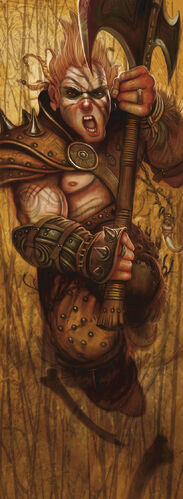
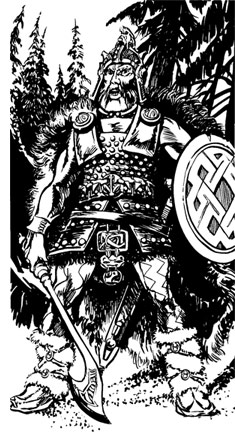
Barbarian
The first class we're covering in 5E is the good old barbarian. And the barbarians are... well, their name sort of says it all, yeah? It's a typical Conan-style warrior, wading into battle with axes and massive swords, all adrenaline and anger as they basically have two principles in battle: hit the enemy, and hit the enemy again. The various monster manuals note how the barbarians tend to shun civilization, either treating it with utter disdain, or only tolerating it for the sake of practicality. They live to fight and hunt, and are always driven by anger. Barbarians tend to be fiercely loyal, either to their tribe or to their adventuring party. I'm not going to go too deep into the specifics of the game mechanics, but in addition to their class features, the Barbarians in 5E essentially work off a 'rage' mechanic, essentially entering a super mode where you can't cast spells but have increased everything as far as combat goes... at least until you get knocked out, at which point the rage dissipates, and all the damage you've been ignoring catches up to you. In some editions, the barbarian is a subclass of Fighter since, well, it's kind of the same thing, just angrier and more reckless. The distinction's more about mechanics than anything.
All of the basic classes allow you to choose one of several 'paths' once you reach a certain level, essentially customizing how your character fights. For the barbarians, the Player's Handbook gives us Path of the Berserker, where your barbarian goes even further into rage-y goodness as their anger increases practically everything they can do -- essentially, you become more barbarian than any other barbarian, going into such a frenzied or mindless rage that both the advantage and the disadvantages thereof are amplified. The second path for the barbarian is the Path of the Totem Warrior, where your barbarian character is going on a spiritual journey -- another common trope for a 'tribal' character. It's a less crazy and more tribal-themed barbarian path, where your barbarian character can choose one of three animal spirits -- bear, eagle and wolf -- and essentially channel the power of your favoured animal in combat. There are multiple different official paths and sub-classes for all of the D&D classes introduced outside of the Player's Handbook. But for the sake of brevity, we're not going to cover all of them. Not here, anyway.
Barbarians have always sort of been kind of a fun character archetype, especially if you're the type of player who wants to just smash everything in your way. D&D tends to be pretty neat at delivering at the various hero fantasies in fantasy fiction, so... yeah, here's your 'murder everything in a mindless flurry of blows' class.
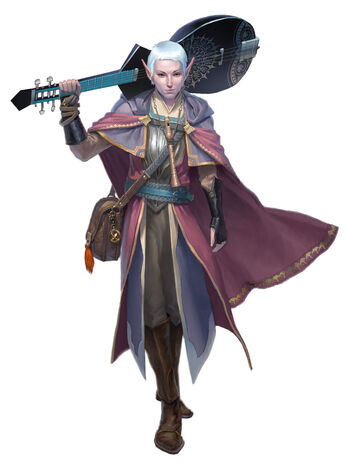
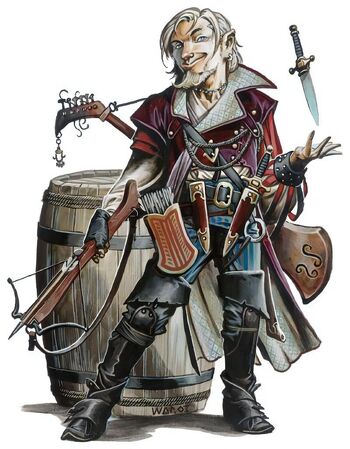
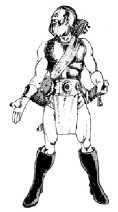
Bard
One of my favourite classes ever is the bard. Playing as a bard is honestly something that's almost unique to D&D, whereas in D&D-inspired video games, bards and their ilk tended to be restricted to NPC's because, well, they play music and support other characters. It doesn't really make for a particularly fun video game experience. But as part of a group? Bards tend to provide one of the more fun, wacky classes you can play, particularly in 5th Edition. And I say this because one of the bard's earliest cantrips in 5th Edition is "Vicious Mockery". Your bard will literally cause damage to the enemies by hurling insults at them! Throw in some other class features, like Cutting Words and whatnot, and your bard roleplaying can essentially be someone who either tells such bad puns your enemies die out of stupidity, or you unleash yo' mama insults so horrible you kill them. Also, being a bard sort of also gives players a chance to point out cliched tropes and lean on the fourth wall -- it's "in character" for a bard to recognize story elements, right? I think bards have been poop for the longest time, since their thing used to be 'jack of all trades', being a little bit good at everything, but this just means that the old-school pre-3.5E bard ends up being pretty much 'shit at everything' instead of being 'versatile but not as good as the other classes'. Nowadays, they're probably one of the best classes, particularly in 5E.
Essentially, bards in 5th Edition are spellcasters that channel their magic through music, and there's a distinction between true bards and any random minstrel or troubadour in a tavern. The 5th Edition blurb on bards note that bards aren't necessarily just performers and musicians, but something like war drums, or people who gather lore and stories about great heroes, or influencers in royal negotiators, or skalds in barbarian tribes, can very well be bards. Words have power, stories have power, and the bards seek to do so. Whether your bard uses their music and stories to simply entertain, or to influence larger events, or to chronicle events, it's up to you! Once sort of a joke in the vein of "you brought a lyre to a sword-and-spells fight", bards are now just straight-up powerful and versatile spellcasters, able to cast spells, buff allies and generally charm and worm your way through negotiations. Bards are able to join a 'college' at 3rd level, and, again, the Player's Handbook gives us only two choices for the moment -- the College of Lore are true jack-of-all-trades, knowing something about most things, and their main loyalty tends to be in the pursuit of great stories and generally the truth. These are the sort of bards that refuse to tell falsehoods for political means, but will tell the undiluted truth. Meanwhile, the College of Valor work more like ancient storytellers that glorify heroes and tell the tales of heroes of the past and present to inspire those of the future. Overall, two neat directions to take your bard character towards,
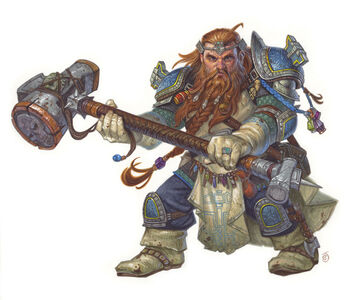
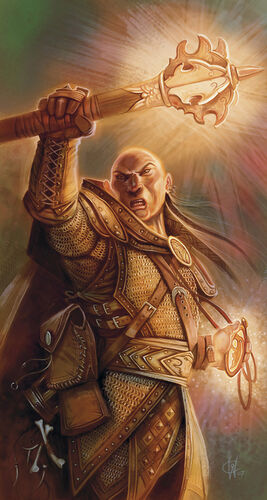
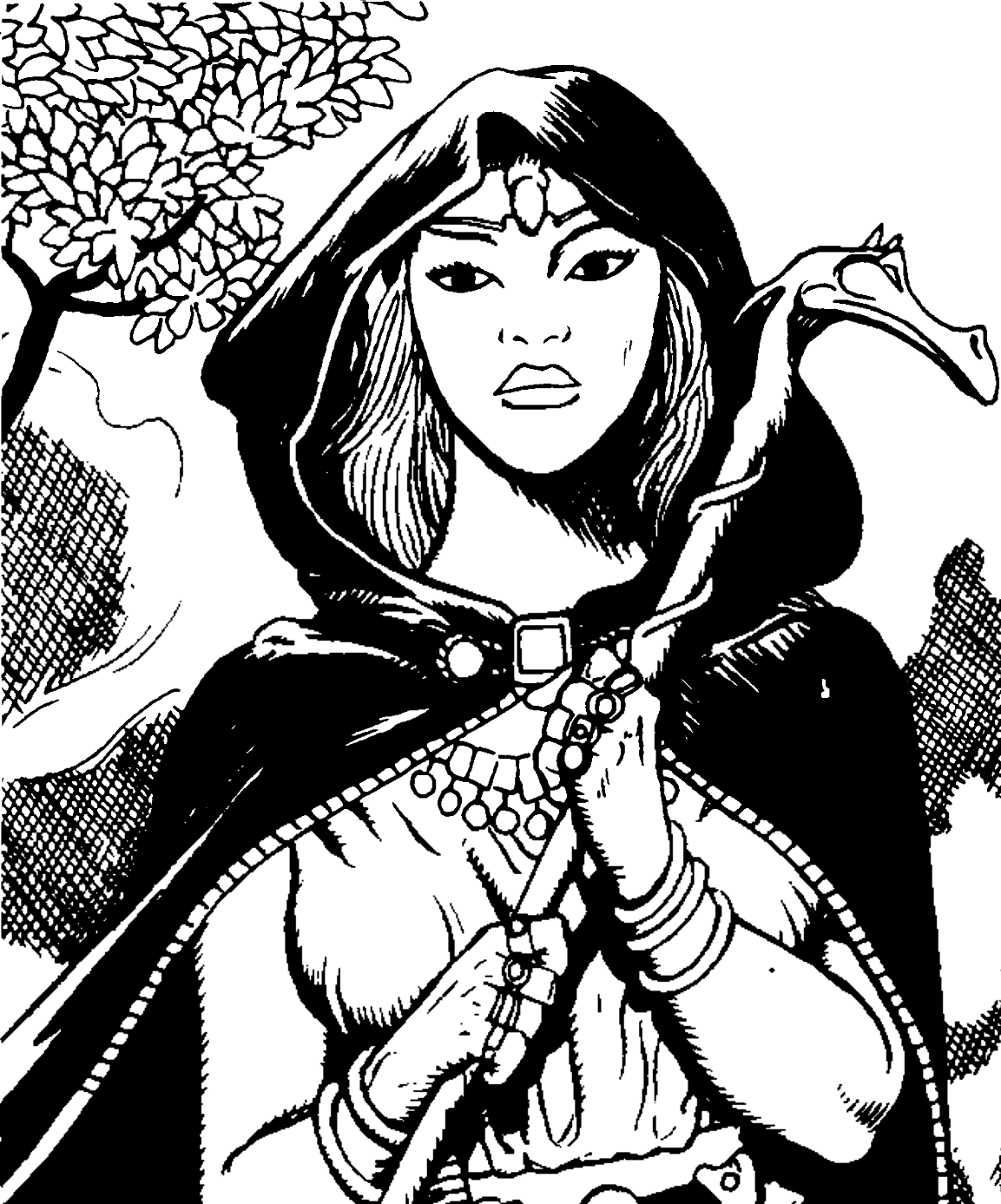
Cleric
Clerics, or "Priests" in some older editions, are the archetypal healer class. They have the most healing spells, and theoretically stand backwards and heal or buff their party, occasionally whacking an ersatz goblin with their mace or hammer if they got too close. In practice, though, clerics tend to be toe the line between being overpowered or being just so dang versatile that they can tank or nuke or heal as needed. Their flavour has also been changed significantly since their original inception. Basically, clerics become a catch-all for any adventurer that revere and serve any god (well, any god from a given list of whatever gods exist in your setting) and asks said god to empower them. Best of all, your powers depend on the deity you worship, so taking some classic mythological gods for example a cleric of Thor will be able to summon thunderbolts, a cleric of Osiris will be able to have control over the dead (grave and death domain clerics don't show up until later supplements, but they're friggin' cool) and a cleric of Ares will be all about glorifying war and destruction.
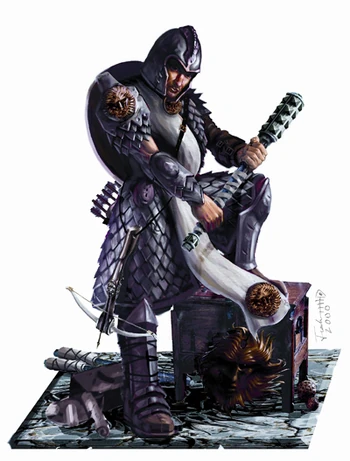 Of course, being a literal servant of a god who is willing to help out their favoured champion with a divine intervention every other week does sort of come with a bit of a price, and that price, of course, means that your cleric character is the most likely to get derailed or given a quest to serve their god. After all, as such a devout and favoured champion of their patron deity, they can't afford to say no, right? Also, even moreso than most other classes, clerics tend to be associated strongly with their particular church and religion, which might raise some neat roleplaying opportunities.
Of course, being a literal servant of a god who is willing to help out their favoured champion with a divine intervention every other week does sort of come with a bit of a price, and that price, of course, means that your cleric character is the most likely to get derailed or given a quest to serve their god. After all, as such a devout and favoured champion of their patron deity, they can't afford to say no, right? Also, even moreso than most other classes, clerics tend to be associated strongly with their particular church and religion, which might raise some neat roleplaying opportunities.
In the 5E Player's Handbook, clerics have the most possible variations, based on the "divine domain" of their god, divided into Knowledge, Life, Light, Nature, Tempest, Trickery and War. A given god might embody multiple aspects, but your cleric character's going to focus on just one particular facet of their god. Life Domain is perhaps the most archetypal cleric. It's all about life, healing and you focus particularly on healing and preservation of life. Light Domain is another facet of the archetypal cleric, except this one focuses more on burning the evildoers of the world with holy flame. The Knowledge Domain allows clerics some focus on seeking and learning about knowledge, and this also extends to things like smith gods liking the knowledge of smithing. In addition to some thematic spells (scrying, identify) clerics of the knowledge domain get some neat powers like becoming super-smart for a temporary amount of time, read thoughts, or see through the past memories of a person or item. Nature Domain has a lot of overlap with druids, but the difference is the way they get their powers, I guess. Tempest Domain clerics worship the gods of weather (like your Thors and Zeuses) and have a bunch of weather-related powers. Trickery Domain is, well, the priests of the Loki-equivalent of your pantheon, where the clerics get powers related to subterfuge and trickery, things like charm person or modify memory. War Domain are those clerics that are charged to go and do war instead of doing all of this healing stuff, and most of their spells are offensive, or at least focuses more on debilitating the enemy.
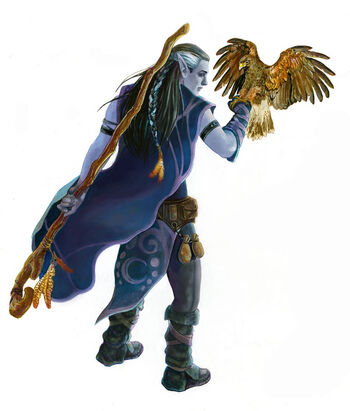
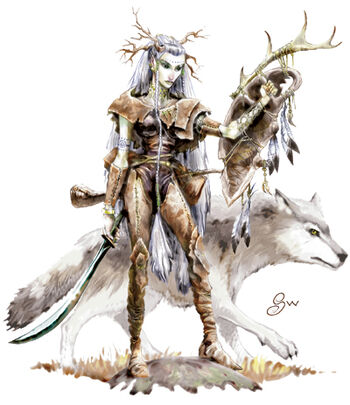
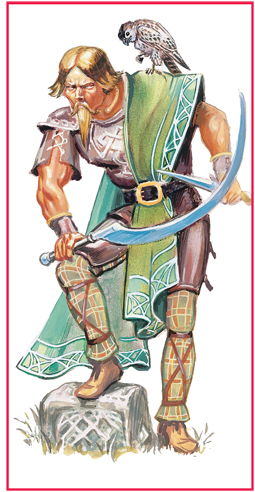
Druid
The other theoretically-flexible-but-actually-just-pretty-damn-overpowered-in-most-editions class is the druid, and I think up until 3E or 3.5E, druids and clerics are essentially the best class and what are you doing taking anything else. Being shamelessly clueless and ignorant about the 'meta', so to speak, I'll just smile and nod. Unlike clerics and warlocks, druids don't channel the power of some greater figure, but instead commune with nature itself, with the building blocks of the world. Be it plants, animals, weather or the elements that form the world, druids are versatile and an embodiment of mother nature's wrath itself. Druids are also able to shapeshift into animal forms, in addition to channeling their power, and tended to have a theme of 'balance'. Balance between their humanoid and animal forms; balance between the four elements; balance between life and death... stuff like that. Like clerics, there's a lot of stuff you can really do with a druid. Perhaps they just come from a tribe where druidic faith is the norm. Perhaps they are raised by animals, or maybe they have some close connection to nature. Also, depending on the setting, druids might actually serve a specific nature god -- again, it's one of those that really depends on what flavour your GM wants to draw from.
While my favourite druid circle is the "Circle of Spores" (which does exactly what you think it would), the two basic druid sub-classes, or 'Circles', are the Circle of the Land and the Circle of the Moon. These basically represent the vast organizations of druids that lay spread across the world, rarely meeting but acknowledging other druids as brethren. The Circle of the Land is the most archetypal druid, with their spells tied to manipulating and communicating with trees and animals. Interestingly, the spells that your druid obtain when they join the Circle of the Land is yet another choice, as your druid gains different spells depending on where they are initiated -- sure, get initiated in a forest or the grasslands and you get your typical set of druid spells, but be initiated into the Circle in the desert, and you can summon locust plagues and create fata-morganas. The arctic, and you get to channel icy energy spells. Hell, get initiated into the druids in the Underdark and you get to command toxic gases. The Circle of the Moon, meanwhile, doesn't actually go Sailor Moon when the fight the enemy, to my disappointment, but rather focuses more on a somewhat werewolf-style "hunt under the guise of animals under the full moon", basically gaining access to a lot more different animal forms (you can basically pick and choose any animal under a certain CR range, meaning that, yes, dinosaurs and stirges), and even elementals.
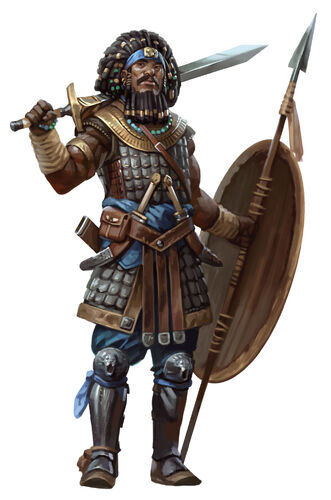
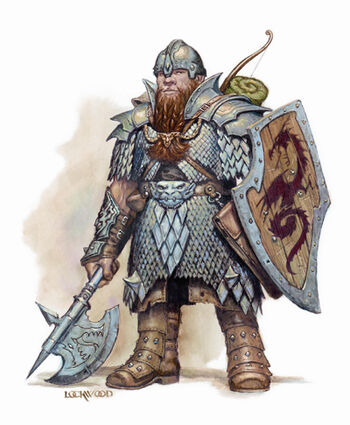
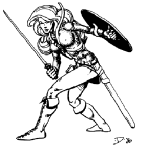
Fighter
Sort of the most "basic" class of sorts, fighters encompass everything else who fights with weapons that don't fall into any of the other class category. Gladiators? Soldiers? Archers? Knights? Tavern brawlers? The original 'default' class, the fighter is basically anyone who can pick up a sword or spear or axe or bow, and, honestly, kind of the class with the least identity. Classes like barbarians and rangers are, after all, significantly more flavourful versions of the fighter. It does basically allow you to build a character from scratch with minimal interference or having to learn any of the mythology of the world, though. You get to make two choices as a 5E Fighter -- you can choose a favoured fighting style (archery, defense, dueling, great-weapon, protection, two-weapon), and then you get to choose a martial archetype, same as the others. The fighting style basically informs your character if they want to be someone who holds a single weapon in a hand (like a fencer), someone who holds a large weapon with two hands (a samurai or a knight), a dual-wielding badass (like anime characters), an archer or a defense-oriented warrior. There's not a whole ton for me to talk about here. Even the martial arhetypes don't offer a whole lot of flavour -- the Champion is practically just a really strong dude with really strong sword skills; the Battle Master are tacticians and the sort of warriors who treat a fight in an almost academic manner and tend to know a lot of extra maneuvers to gain an advantage in combat; and Eldritch Knight, who uses a bunch of defensive abjuration spells and offensive evocation spells to fight in battle, becoming like a mage-warrior of sorts. Not a whole lot for me to say here -- fighters are relatively simple in both flavour and mechanics fIor a purpose.

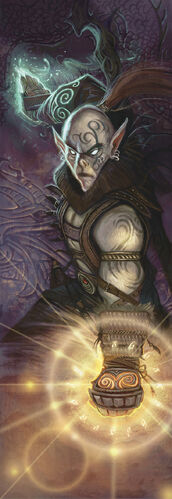
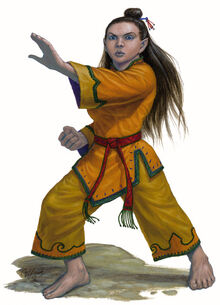
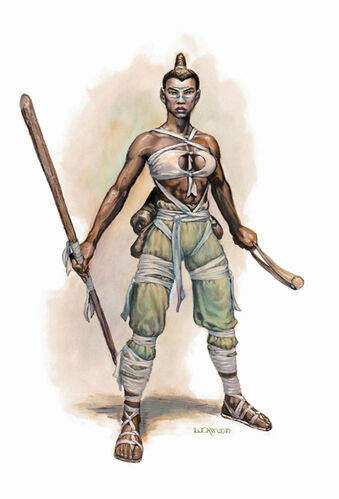
Monk
Yeah, D&D was created right at about the time that Shaolin wuxia movies become pretty popular, and while the monks in D&D aren't quite as obvious Shaolin expies as they used to be, bare-handed martial artists that can wachaaaa and kung fu smash a triceratops to the dirt with nothing but their bare fists has always hung around. Some people argue that they're kind of offensive, but as an ethnically Chinese person, I am happy that at least some aspect of our culture bled into the otherwise very Euro-centric D&D. In 5E Monks basically have a unique mechanic of ki, the spiritual energy within living creatures, and it's the channeling and disciplined control of ki that allow them to basically do superhuman feats with their fists. (In practice, your monk character regenerates ki over time and spend them to activate skills) Very anime, very wuxia. I approve. Thanks to the whole ki deal, monks tend to train under a specific school or monastery to learn the art of ki manipulation as well as the soul-searching that comes with it. Monks aren't always restricted to bare fists, but they do get bonuses for limiting themselves to simple, light weaponry and not wearing any bulky armour. Also, all monks are able to Fist of the North Star style ATATATATATATATA (or ORAORAORAORA for JoJo fans out there) with their 'flurry of blows', or do some Bruce Lee awesomeness with 'deflect missiles'. Monks have a lot of funky abilities based on kung fu movies and anime in general, and I just love how unabashedly obvious some of the 5E 'ways' are. Especially considering how monks are widely considered the shittiest core class from 3E and 3.5E, and not even published until the tail-end of 4E... it's a neat bit of redemption for the class.
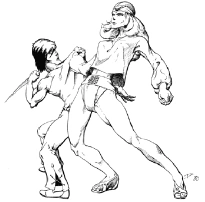 The Monks in 5E are able to pick one of several monastic traditions, which are specific schools of monk arts... which, again, very reminiscent of old-school wuxia shows. The Way of the Open Hand basically have such a mastery of general weaponless hand-to-hand combat that they can even disrupt the enemy ki and disable their abilities with what's basically pressure-point strikes, and, my favourite, is the Quivering Palm, which is basically a "you are already dead" technique where the Monk's strike unleashes a lethal vibration that acts like a time bomb, with their body being wracked by damage minutes to days after your monk deals the lethal blow. Omae wa mou shindeiru indeed. Way of the Four Elements basically turns your monk character straight-up into Avatar: The Last Airbender, because... well, that's basically what these four-elements monks do, manipulating the ki of the elements around them and empowering their martial arts with the force of the elements. The Monster Manual even notes that monks of the Four Elements like to tattoo their bodies. Tattoo an arrow on your monk's head! Way of Shadow monks, meanwhile, are the stealthy ninja-assassins of the world, with the Player's Handbook straight-up calling monasteries that specialize in the Way of Shadow as ninjas. In addition to some sneaky and stealth spells, Way of Shadow Monks are able to basically walk within shadows and become one with the shadows themselves. Subsequent supplementary material would add a whole lot of extra monk way-of-the-X that would essentially allow you to pick whichever flavour of fancy anime tropes you prefer.
The Monks in 5E are able to pick one of several monastic traditions, which are specific schools of monk arts... which, again, very reminiscent of old-school wuxia shows. The Way of the Open Hand basically have such a mastery of general weaponless hand-to-hand combat that they can even disrupt the enemy ki and disable their abilities with what's basically pressure-point strikes, and, my favourite, is the Quivering Palm, which is basically a "you are already dead" technique where the Monk's strike unleashes a lethal vibration that acts like a time bomb, with their body being wracked by damage minutes to days after your monk deals the lethal blow. Omae wa mou shindeiru indeed. Way of the Four Elements basically turns your monk character straight-up into Avatar: The Last Airbender, because... well, that's basically what these four-elements monks do, manipulating the ki of the elements around them and empowering their martial arts with the force of the elements. The Monster Manual even notes that monks of the Four Elements like to tattoo their bodies. Tattoo an arrow on your monk's head! Way of Shadow monks, meanwhile, are the stealthy ninja-assassins of the world, with the Player's Handbook straight-up calling monasteries that specialize in the Way of Shadow as ninjas. In addition to some sneaky and stealth spells, Way of Shadow Monks are able to basically walk within shadows and become one with the shadows themselves. Subsequent supplementary material would add a whole lot of extra monk way-of-the-X that would essentially allow you to pick whichever flavour of fancy anime tropes you prefer.
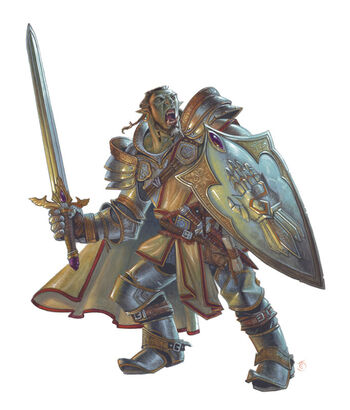
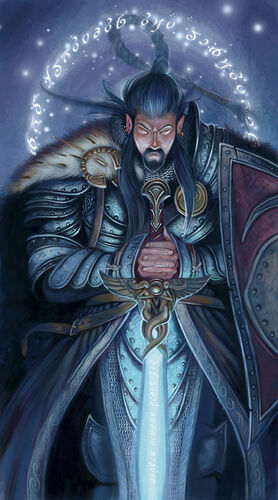
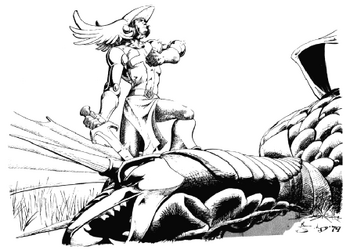
Paladin
And, hey, here's the Paladin! Paladins are knights taken up to eleven, being holy knights whose word is their bond, who swear oaths to mightier beings, blessed champions who wander the land and smite the evil and protect the weak. I used to think that Paladins are pretty bland, basically clerics and fighters merged together into a mixture of fighting and healing skills... until I actually saw people role-playing as paladins. Unique to paladins and something not shared by any of the other worship-a-deity classes, paladins actually work off a proper karma system, and they will lose all of their fancy powers if they do one too many evil acts. Of course, the specifics vary from edition to edition, as are the penalties, but it is truly fascinating to see just how much your GM's setting is going to tolerate a paladin's misbehaviour, or how much of an 'evil' act is considered dishonourable. Sure, beheading and brutally torturing a surrendering enemy will send a paladin down that nasty road, but what of more... morally ambiguous acts? Is pre-emptively destroying a goblin camp that has a very high potential to attack the nearby village a vile, heinous act of blanket-judging an entire race because of their "always chaotic evil" tag? Or is it an admirable decision that will prevent a lot of deaths in the long run? Is the intention of the paladin what matters, or is it the result? Can a paladin's justifications for certain controversial acts actually stave off the 'punishment' from their deities? Or maybe the deities themselves are not infallible and actually agree with a harder hand? Whatever the case, when a paladin breaks their oath -- be it an oath to their god or something lesser -- they might have to go through a whole soul-searching quest of penance, or, if they're unrepentant or are corrupted of evil, stripped entirely of paladin powers. Think Arthas Menethil from Warcraft.
 Like clerics and warlocks, 5th Edition offers a bunch of potential role-playing options for paladins, and a paladin player isn't pigeonholed into basically having to be goody-two-shoes-Uther-Lightbringer all the time. Sure, most paladins are like that, but some are act more like angels of vengeance, sent by their god on a mission to eradicate evil where they may lurk (and paladins can essentially 'smell out' evil)... no matter the cost. It's always these sort of gray-area paladins that always fascinate me as character, and, honestly, while I didn't think that I would find paladins to be one of the cooler classes... they certainly are! Whether it's the selfless paragon of virtue; or a snotty, self-righteous prick; or a mysterious fallen paladin, it's always so interesting to see paladin characters and the roleplaying opportunities they provide.
Like clerics and warlocks, 5th Edition offers a bunch of potential role-playing options for paladins, and a paladin player isn't pigeonholed into basically having to be goody-two-shoes-Uther-Lightbringer all the time. Sure, most paladins are like that, but some are act more like angels of vengeance, sent by their god on a mission to eradicate evil where they may lurk (and paladins can essentially 'smell out' evil)... no matter the cost. It's always these sort of gray-area paladins that always fascinate me as character, and, honestly, while I didn't think that I would find paladins to be one of the cooler classes... they certainly are! Whether it's the selfless paragon of virtue; or a snotty, self-righteous prick; or a mysterious fallen paladin, it's always so interesting to see paladin characters and the roleplaying opportunities they provide.
Like fighters, Paladins have a bunch of fighting style they can choose, although less variable than the fighters. The 5th Edition Paladin sub-class allows them to pick one of three oaths, and, like clerics, they are able to channel their divine patron for a limited amount of time. The Oath of Devotion, as always for the first choice in the Player's Handbook, is the ur-Paladin. They're the paragons of justice, seeking to reach the ideal of becoming the standard of justice to the world. They are justice, because they exemplify all the tenets of honesty, courage, honour and duty that represents justiec. The Oath of the Ancients is an interesting variation of the paladin. Paladins that follow this oath don't do so because of some personal stake of honour or courage, but because... they simply love life, and decide to protect it against the darkness and evil. They seek to be the Light, to inspire others, and their spells tend to have a quasi-druidic bent to them. The final one, the Oath of Vengeance, basically has your paladin character become Batman. Or the Punisher. Their righteousness doesn't matter. The cost to their life doesn't matter. Only the mission of vengeance, of wiping out the evil [insert enemy here] matters. They are the avengers, the dark knights, and while they aren't necessarily evil, sometimes their crusade might cause them to show no mercy in dealing with their enemies, and sometimes gets so hell-bent on slaying the greater evil. They're still paladins, though (the obligatory 'evil paladin' blackguard classes aren't here yet) and while they might stop and help those harmed by evil, the mission always comes first.
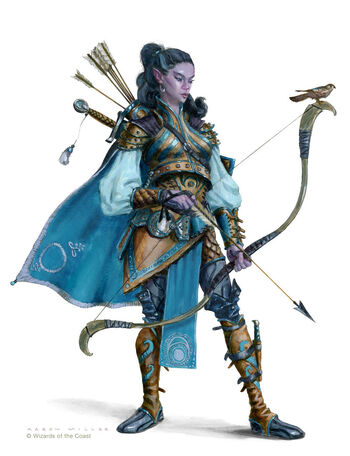
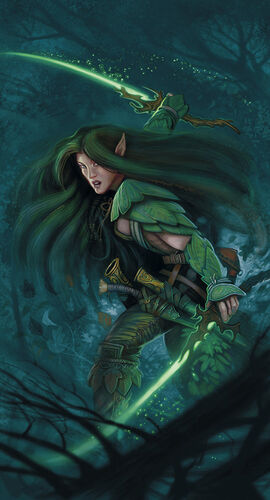
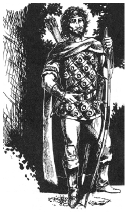
Ranger
Sort of the butt-monkey of the original 5E classes, the rangers are... not the best class out there, although we won't get too much into the specific game mechanic reasons why. Rangers hunt evil beasts with their light weaponry, sneaking around, able to be aware of their enemy, tracking their quarry like a predator and turning the hunter into the hunted. They basically work off of a 'favoured enemy' and 'favoured terrain' deal, where they gain bonuses when in the right location or fighting the right enemy, but kinda... iffy when fighting against others, and it's not until later buffs and errata that the 5E Ranger became far more practical to pick. They have the access to some of the warrior weapon fighting style, as well as some spellcasting abilities. Their archetypes are split into two: Hunters and Beast Masters, which... yeah, very World of Warcraft Hunter, yeah? 5E Hunter basically learn specialized techniques to fight creatures and whatnot. Beast Masters cause your ranger to bond to a specific animal companion like a companion bear or wolf and you sort of get two-characters-in-one... which sounds cool, but again, in practice, this starts losing value once your bear ends up facing off against balors and remorhazes. Basically, you need to pick up one of the many 'revised/fixed Ranger' options if you plan to play a 5E Ranger. Playing as a hunter's pretty neat, honestly, although I really don't have much to say here. They look neat, but in 5E they're not that good.
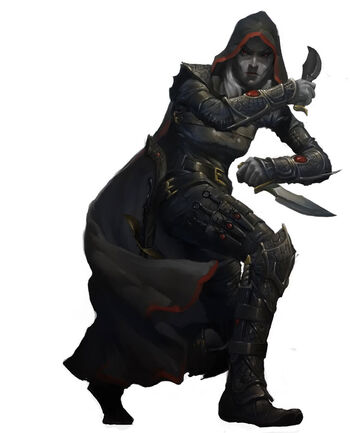
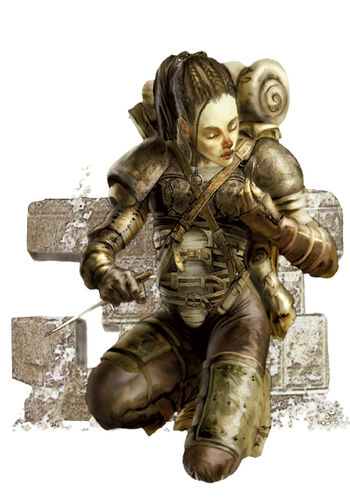
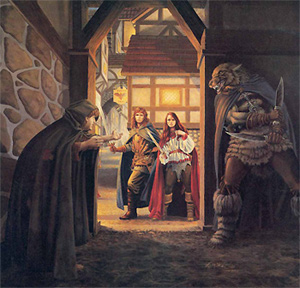
Rogue
Rogues, sometimes known as "Thieves" in older editions, are... well, they're another one you recognize almost immediately, yeah? They're shit in a fair one-on-one fight, but why the hell would they allow them to happen? They sneak in the dark, they check for traps, they pick the pockets of NPC's, they stab foes right where it hurts, they coat their blades with poison, they steal the enemy's magic weapon before the fight, they dodge enemy attacks while they sneak around. They're the assassins of the world, the spies and the thieves and the charlatans, using every resource under the sun to gain an advantage against whatever they're facing. Rogues are kinda-sorta pigeonholed into a non-lawful alignment, and the Player's Handbook does note that almost all rogues tend to be associated with a thieves' guild or a crime family -- if not in the present, then in the past. It's actually a very, very obvious plot hook -- just how are your rogue's old criminal associates going to react with your rogue character palling around with a group of presumably morally-upstanding citizens? An interesting tidbit is that rogues have a unique jargon called Thieves' Cant, sort of a series of codewords and a 'thieves' language' that allows the various rogues around the world to communicate without being privy to the ears of non-rogues.
In most editions, the Rogue's most useful ability is the Sneak Attack -- the mechanics differ, again, from edition to edition, but basically the Rogues make use of an enemy's inattention to shiv 'em right where it hurts. Rogue archetypes in the Player's Handboook are: the Thief, which basically focuses on burglary, climbing up buildings and generally pickpocketing random NPC's blind. The Assassin, where your character becomes Ezio Auditore da Firenze, being masters of infiltrating and dealing death-blows. And the Arcane Tricksters, which are, well, basically rogues with spellcasting abilities. I think flavour-wise these are the more... mischief-making rogues? Why steal with your own hand when you can do so from a distance with a Mage-Hand? In what's somewhat expected for a magic-wielding rogue, a particularly powerful Arcane Trickster is able to straight-up steal spells from other spellcasters. A bunch of relatively expected tropes, but ones that are pretty cool.
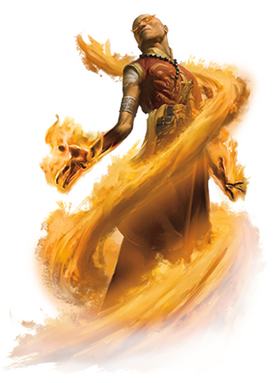
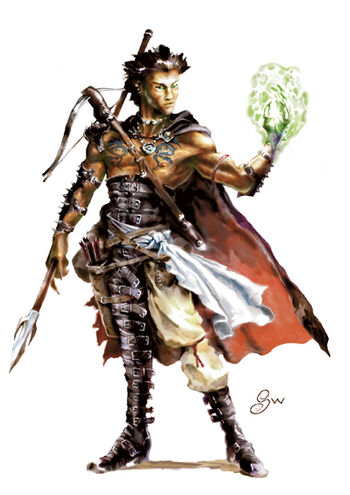
Sorcerer
Introduced in the 3rd edition, I believe, are the sorcerers, which... well, they're basically kind of like X-Men Mutants, I guess? Unlike the wizards, who actually have to learn how to wield magic, the sorcerers draw on an internal storage of magic. Whether this comes from just something in-born, a powerful supernatural being like a fiend, fey, godling or dragon somewhere in the sorcerer's bloodline, or them being exposed to some sort of magical artifact, or them just being born with unexplained magical powers, sorcerers essentially are powerful but a lot less controllable. They're made out of pure, raw magic, channeling magic without the training that wizards or monks have, nor do they have any sort of patrons like warlocks or clerics. And, well, the sorcerer's motivations might be different, depending on whether they view the magical powers as a curse, or more of a blessing. In 5th Edition, this allows a sorcerer to basically use 'sorcery points' to be flexible. They get less spells per day than wizards, but by spending the points, they can basically make said spells be exponentially powerful with the 'metamagic' mechanic, or simply claim a bunch of extra spell slots. And, well, 'metamagic' is pretty damn powerful, allowing a sorcerer to modify the spell to have greater damage, greater range, a longer duration and many other variants, depending on the situation.
Unlike other classes, the Sorcerers choose their archetype at character creation, because it influences the origin of their Sorcerer magic. The handbook just gives us two -- Draconic Bloodline and Wild Magic, but, of course, supplementary material adds a lot more. Draconic bloodline sorcerers obviously draw their sorcerer magic from a dragon somewhere in their bloodline, and depending on the dragon type, it amplifies certain types of spells. You sort of become the Dovahkiin, really, and at higher levels you gain the ability to sprout dragon wings or to channel the dread presence of your dragon. Which... sort of means that this one is either redundant or particularly appropriate with a Dragonborn PC. Wild Magic, on the other hand... there are other features to it, but the most important and memorable one is "Wild Magic Surge". It's basically Hearthstone's RNG on steroids -- chaotic wild magic of unknown origin (it could be fey, elemental, Far Realm, et cetera) runs through the wild-magic sorcerer's blood, and nearly every time this sorcerer casts a spell, you have a 1 in 20 chance to cause a random effect selected from a table to happen. It can be something as innocuous as your skin turning blue, you being surrounded by ethereal music for a minute, a certain spell or two being unleashed upon you (fireball yourself!), random creatures like a Modron or a Flumphs appearing for no reason... or, my favourite, "you turn into a potted plant". In 5E, there was some debate on just how much the Sorcerer class compares to the other dedicated caster classes, and... again, I don't delve too deeply into the meta or look too hard at the skills and numbers.
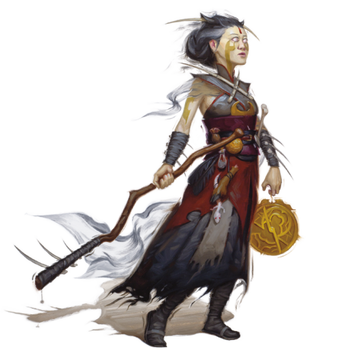
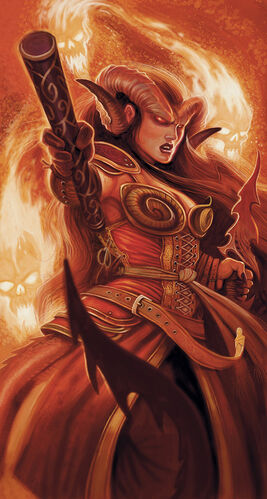
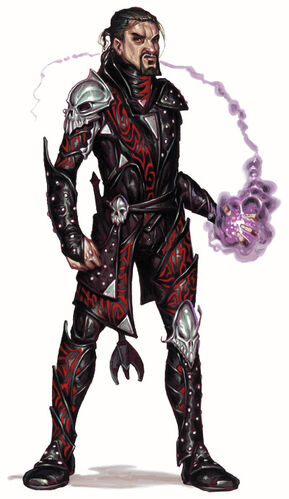
Warlock
The original Warlock class is another one introduced in 3E, and are spellcasters that receive particularly powerful forces through a pact with an otherworldly being like a demon, devil or a fey, and they tap onto these massive fonts of power to unleash their magical powers. In 4th and 4th Edition, the potential patrons that a warlock can sign a pact with include... well, basically anything from a sentient magic weapon (Hexblades are overpowered), some mysterious lurker deep within the ocean (Cthulhu fhtagn) or some extradimensional Great Old One from a dimension you do not comprehend (ia, ia, Shub-Niggurath), or even a 'ghost in the machine' for a more sci-fi bent. Warlocks are easily compared to clerics, since they're both classes that serve a greater entity, but a warlock's relationship with their extra-dimensional sugar-daddies isn't always as one-note as the clerics and their gods. Sometimes, it's a master-and-apprentice deal. Sometimes the warlock draws power without the greater being even noticing. Sometimes the greater being tries to slowly corrupt the warlock and acts as a 'beast within'. Sometimes they're just good buddies. Sometimes it's a Constantine-style hell-pact. Sometimes they don't even realize they even came into contact and a pact with a powerful archfey until they start being able to unleash warlock powers. Sometimes the warlock is actively trying to break free of the deal they've unwisely made with their
The Player's Handbook notes that warlocks are almost always seekers of knowledge, but I've always felt like the most interesting thing is the Warlock's dynamic with their patron, of which there are many permutations of. The Player's Handbook gives us three choices, the obvious ones: the Archfey, the Fiend and the Great Old One. The Archfey, of course, grants the warlock access to spells that are fey-themed, including illusions, mind-domination and the warlock slowly gains more and more fey powers as they grow, eventually allowing your warlock to even create illusory realms to plunge their victims into. The Fiend is either a demon or a devil, and, well, tends to be on the far more malicious side of things as compared to the capricious fey. Their spells tend to be more destructive, your interactions with your patrons also tend to be more destructive, and at higher levels you can quite literally throw your foes into hell. The Great Old One, meanwhile, is any entity that is foreign to reality, a Lovecraftian creature with great secrets and knowledge... and as with any self-respecting Elder One, they tend to really not give a shit about your character. Doesn't stop you from drawing power from them and casting Evart's Black Tentacles, though! Great Old One Warlocks tend to have mind-warping and mind-controlling powers.
As your Warlock grows, their patron will grant them one of three pacts: the Pact of the Chain causes your patron to give you a personal familiar. Pact of the Blade is the same thing, but with a weapon. Pact of the Tome gives you an extra book of spells. Overall, this is a class that I think ends up being expanded upon a lot in supplementary material, but by virtue of being a character that's bound to either a malicious demon/devil, a capricious and unpredictable arch-faerie or a slumbering Elder God Sleeping Between The Stars... yeah, the warlock's pretty awesome.
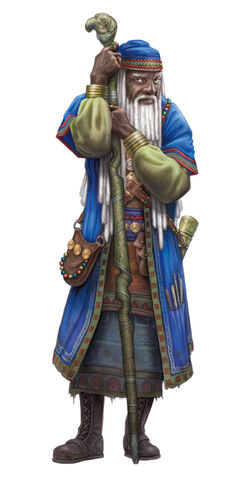
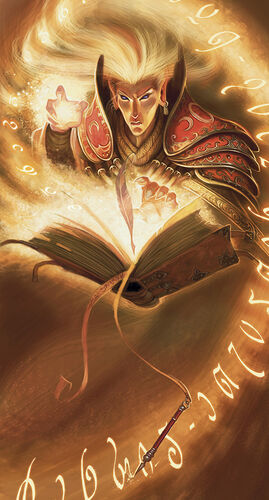
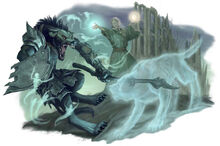
Wizard
Going through several names like "Mage", "Magic-User" and "Wizard" over the years, eventually, the flavour of someone who dedicates his or her life to the study of unlocking the arcane secrets of the world, learning them the hard-and-proper-way-gosh-darn-those-dang-sorcerers and having the widest range of magic, the wizards of the world are the scholars and manipulators of the arcane, able to manipulate reality itself to their whim. They're perhaps the one that's the most dependent upon their spells, although as always trying to compare wizards with the other spellcasting classes requires a dissection of the mechanics. Flavour-wise, I feel like D&D does a pretty neat job at making the different spellcasting core classes feel unique. Wizards also have a personal spellbook, and they actually do have to copy the powerful words of power into the spellbook in order to essentially have a quick-draw access to their spells.

While all the other spellcasters might replicate the same spells, wizards know that there are eight different schools of magic, each informing a certain set of spells and a certain specialization. Not all wizards are pigeonholed into their school of choice, although they do get perks for picking a specialization. To go through the eight schools of magic quickly in list form:
And... and that's it for now! We have a far lengthier article, huh? I ended up talking a bit too much about the player classes.
The 5E stuff for the creatures we covered here:
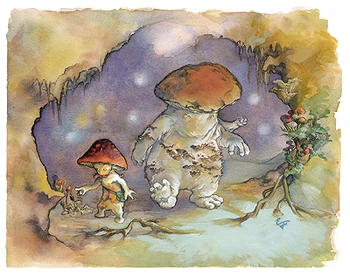 |
| Myconid (3E) |
What's perhaps most interesting about the Myconids is that despite looking like they should be monsters -- fungi tended to be associated with poison and rot, after all -- they're actually very much neutral, which is very rare for Underdark races. Most of everything in the Underdark tended to want to murder any sentient being that comes across them! They distrust outsiders very much, but they tend to not be hostile, because they seek enlightenment, and unless unavoidable, will try to not get violent at all. And when they do, they tend to just rely on fists, primitive fungal-based weaponry, or by weaponized spore. Which is probably like the fungal equivalent to either babies or sperm cells. Best not to think too much about it. A lot of what I remember from them is a combination of the 3.5E bestiaries and their Underdark sourcebook, but 5E does give a new spin instead of just regurgitating old material.
 |
| Myconid Sovereign (5E) |
While they're benign, the Myconids are still fungal people and they do have some creepy abilities. From 4E onwards, we've been having Myconids with various features taken from various real-life mushrooms instead of just a toadstool, and I do like that 4E artwork with two burly Myconids with spiky gauntlet-like arms, that somewhat wizard-like dude with gangly arms, and the phallic-headed leader in the background. 4E has always been the edition that goes way too overboard with listing like five or eight different variations of each race, but for the Myconids, it's one of the few where the stark variation feels actually appropriate considering how different the Myconid sub-types look in the artwork.The artwork for 5E also shows us two very distinct-looking mushroom dudes based on different mushrooms, and... and is that a brain-fungus Myconid dog in front of them? For 5th Edition, it's mostly just regular Myconids and the Myconid Sovereign, which comes with the ability to create Spore Servants, which is sort of a unique method of necromancy-via-spores... Pretty cool stuff! Again, it's something that I draw from the Myconids' portrayal in previous editions, but while most circles and colonies are peaceful, some Myconids do either go on a very expansionist bent and they just consume and expand more and more throughout the Underdark, or they get corrupted by some malign force (to use a canon D&D villain, Zuggtmoy the fungal-themed Demon Lord would probably work) and instead of being big lumbering mushroom bros, they become angry zombie-making mushroom bros. Honestly, the Myconids are pretty damn cool.


Naga: Bone Naga
 |
| Naga (4E) |
Just how human the Nagas' faces, like the manticore, depends on the art direction for the particular edition, with 5E going for the Naga's faces having humanoid features, but not quite as uncanny-valley as 1E or 3E's art. The flavour for the Naga as a whole is that they're created as immortal guardians by some bygone ancient culture (there are a lot of ancient cultures in fantasy, huh). Immune to aging and sickness, and when struck down, their spirit reforms in a new body. The Nagas have ended up declaring themselves the master of the ruins of their masters' civilization, and while not quite as aggressive as some other races, their culture essentially revolves aroud guarding and acquiring information and magical artifacts. How benign or tyrannical they are is up to the individual, but Nagas basically really love to act as the supreme rulers of their domains.
The Naga always come in many different flavours, and the first we're going to talk about is the Bone Naga... which is probably not the best one to really start of with, actually. The Bone Naga is essentially an undead Naga, which looks pretty damn cool. But the Bone Naga is a shell of what a Naga should be, having been transformed with a necromantic ritual by the Yuan-ti into a skeletal servant without much memory of the spells it knew in life. The Naga and the Yuan-ti apparently have a huge beef, and are rival races. I do find Bone Nagas to be cool. 5E's artwork leans a bit too much towards it just being a snake skeleton with the upper half of a human skull merged with snake jaw bones, though -- I really like the odd look of the original 2E artwork with the long, tapering human rib bones, or the far crazier-looking jagged mass of bones from 3E.


Naga: Guardian Naga
The next couple of Nagas are the more 'basic' Nagas. Guardian Nagas are lawful good, and tended to look a lot less sinister than their brethren. Well, as non-sinister as a serpent with a human face can be, anyway. They protect the sacred tombs and reliquaries, and stop items of magical power from falling into evil hands. They stay in their lairs and basically just stay and plan for "convoluted plans" to stop evil. So, like, they're the reverse-version of a typical superhero villain, then?
Guardian nagas are mostly just there as either NPC allies or quest givers, but a pretty flavourful one. Or, if your GM is anything like mine, set up a misunderstanding where the Naga thinks your party is trying to plunder its lair while the party is like "holy crap snake monster!" While they're not the most dangerous enemy out there, but their nature means that they will keep coming back again and again, something that, according to the Monster Manual, can only be undone by the mighty wish spell. Which means that you'll probably have to get creative in dispatching the nagas you face. You can probably negotiate with a Guardian Naga, but, of course...


Naga: Spirit Naga
There's the evil member of the bunch. I'm not sure which I like more, the utterly bizzare and tortured looking 3rd edition artwork with a wretched, ragged-hair human head plastered on an oddly bent snake body, or the simply cool-looking giant cobra creature from 5E. Either way, the Spirit Naga are the evil representatives of the naga, lurking in dark dungeons and enslaving those who have wronged them with their mind-domination powers. They continually plot revenge against those who wronged them, and the fact that they keep coming back to life is definitely a problem... you can't kill it permanently with fireballs and swords, and there isn't even the option of "well, gotta make a side trip to hell to kill that one pit fiend!" So your party needs to get a bit creative. Imprisonment? Sic a yuan-ti tribe to turn it into a bone naga? Teleportation to a different continent? Toss it into another plane and make it the Abyss or the Feywild's problem? (I don't recommend that last one, lest you want a recurring naga returning with warlock abilities)
Anyway... nagas are pretty cool. Definitely underused, and one I've never really paid too much attention at until my GM threw one at me, but pretty cool.



Nightmare
Horses always have this pretty dang cool association in our minds, particularly in Middle Ages inspired settings like what D&D, at its core, is meant to represent. And horseback riding is a huge point in these settings, which led to a lot of horse-based mythological creatures like pegasi, unicorns, centaurs and hippogriffs... all relatively heroic equine creatures. But what about all the edgy death knights and legion devils that want to ride around horses like all the cool kids? What about the evil riders like the Ring Wraiths or the Headless Horsemen? Well, you have the Nightmare, a burning, shadowy hell horse of doom. And honestly... it took me way too long before I got the pun in this critter's name.
Nightmares are supernatural demon horses that basically only allow creatures of evil to ride them. They're sentient, and they are summoned from the lower planes. And they require a sacrifice, otherwise, like all domesticated animals, they will refuse to obey orders. The origin story for the Nightmares is that they are pegasi that are captured, tortured and transformed through foul magics to become the insane fiend entities that are the Nightmares. Absolutely love the demonic bony fangs they have from 4E onwards.



Nothic
The Nothic is a critter introduced in 3E that I've sort of glossed over and written off as "weird, creepy cyclops ghoul" in my head for the longest time. I mean, it's neat for sure, and the 3E artwork with the gaunt pose and the bizarre head anatomy and that perfect crazed look on the Nothic's face, but I've never really paid it much attention. There were too many weird things in 3.5E's bestiaries that the Nothic just sort of fell by the wayside. While there was certainly something interesting in them, mechanically, flavour-wise they were just one of many random aberrations from the Far Realm, and look positively mundane after you get past their "man, what a weird ghoul-like creature" bit.
And... well, the Nothic instantly became one of my new favourites when my current gaming group bought the 5E starter set, and the small campaign that we tried out within had a Nothic for one of its encounters in a room. And it's this specific encounter that ended with me walking away and considering the Nothic as a pretty dang cool creature. It behaves so strangely, just content to lurk in the dark and just watch with that massive eye and a grin, using its gaze to somehow rot the flesh of random humanoids that wander a bit too close. The backstory is that they are wizards who end up accidentally peering too much in all that search for ultimate power, and accidentally gets exposed to a curse left behind by one of D&D's recurring big bads, the lich-god of secrets Vecna, and they get turned into one-eyed gibbering monstrosities. They retain none of their past personality, but are tortured with the knowledge that there is a method to reverse their condition... even if they don't even remember what, exactly, is wrong with them. Since they were cursed by a godlike being of secrets, this means that despite their insanity and their lack of comprehension, they're able to know a whole lot of secrets, like some sort of crazy, twisted seer or oracle. And just by looking at your characters, the Nothic will slowly gain some random trivia and insight about them. And this little blurb in the 5th Edition's Monster Manual ends up turning the Nothic from just a weird gangly cyclops-ghoul into such an interesting creature, someone who's seeking knowledge due to some vague nagging at the back of their mind, a creature who ends up knowing and learning about information simply by sight... That's honestly pretty cool, and I genuinely wished that more adventures utilized Nothics more, maybe as NPC's or a creature you could persuade to help out with giving you some sort of information or something.



Ogre
Ogres are one of those monster names like "troll" and "giant" that just vaguely translate into a big, burly, savage humanoid, something that I've mentioned multiple times have never really appealed to me. Even among D&D, I've always found the ogres to be the most boring of the various giants -- the true giants at least had the whole lore about them being progenitor races, and trolls tended to have a lot more variation in their kind to make them a bit more interesting. And the goliaths have basically taken over the little niche of "civilized giants". Which leaves the ogres kinda just there as a simple hulking brute of an enemy. They don't even really have a consistent look being some sort of giant humanoid, with 2E and 3E going for hairy and somewhat ape-like, while 4E and 5E go for rotund and burly, sort of like a cyclops. Ogres are big, they get angry easily, they are dumb, they are greedy and they eat humanoids. I really don't have much to say here, and feel like many other giant-style enemies in D&D have so, so much more personality than the genuinely basic ogre. They're neat as



Half-Ogre/Ogrillon
The 5E Monster Maunal also lists a stat block for Half-Ogres or Ogrillons. In previous editions, Ogrillon was a specific type of Half-Ogre that bred with a Half-Orc. (Warcraft's Mok'nathal race is basically the Ogrillons with a new name) Ultimately, though, other than the rather... questionable way that the breeding happens, the Half-Ogres and Ogrillons are basically slightly smarter than their full-blooded ogre parents. They're more likely to be civilized, but, y'know, still ogre. 5E notes that only human, orc, bugbear or hobgoblin pairings can provide half-ogres, while the ogres will eat other races. Okay.


Oni (Ogre Mage / Oni Mage)
 A lot of the creatures in the older sourebooks tended to draw from Eastern myths as much as they do Greek, European or Egyptian myths, but sometimes there's this weird bit where they're clearly adapting a creature from Eastern legend (like the gold dragon!) but then end up changing it into something more... localized. One example would be the Oni, from Japanese culture, who for the longest time flip-flopped between being called an 'ogre mage' or an 'oni mage' or any combination of those. And, again, just how much they draw from the depictions of oni in Japanese culture, and how much they're just boring ol' ogres with mystical abilities, tend to vary from edition to edition. 5th edition... goes for a slightly more original style, making the oni look more like a supernatural bogeyman instead of the "horned ogre-men with weapons" that they looked like in the past. I'm genuinely not sure which I prefer -- although my favourite Oni artwork has to be the Night Haunt variant from 4th edition. 5E, as usual, tries its best to take the original 1st edition Ogre Mage and build from there, adding inspiration from the 2E through 4E.
A lot of the creatures in the older sourebooks tended to draw from Eastern myths as much as they do Greek, European or Egyptian myths, but sometimes there's this weird bit where they're clearly adapting a creature from Eastern legend (like the gold dragon!) but then end up changing it into something more... localized. One example would be the Oni, from Japanese culture, who for the longest time flip-flopped between being called an 'ogre mage' or an 'oni mage' or any combination of those. And, again, just how much they draw from the depictions of oni in Japanese culture, and how much they're just boring ol' ogres with mystical abilities, tend to vary from edition to edition. 5th edition... goes for a slightly more original style, making the oni look more like a supernatural bogeyman instead of the "horned ogre-men with weapons" that they looked like in the past. I'm genuinely not sure which I prefer -- although my favourite Oni artwork has to be the Night Haunt variant from 4th edition. 5E, as usual, tries its best to take the original 1st edition Ogre Mage and build from there, adding inspiration from the 2E through 4E.The 5E oni is noted to be fearsome creatures of the night that stalk forests and villages to kidnap children and feast on them, something that certain yokai and oni in Japanese myths like the Tengu and Yama-uba are known to do. Being big blue giants, the oni are able to use their spellcasting abilities (they're ogre mages, after all) to transform into mist, or even smaller forms. They also tend to hide during the day, pretending to be travelers or simple passers-by, upon which they infiltrate a town and befriend its 'mark', the very people it'll try to snack on. It's honestly probably not the best and most comprehensive adaptation of oni in general into a fantasy game. It's kinda neat that D&D Onis have sort of their unique spin to them, which takes the original concept of Japanese onis and adapting some facets of it, but I also kinda wished that they had done more, y'know?
PC Classes:
 This is a bit of a quick rundown of the 5E base classes, as covered in the 5th Edition Player's Handbook. Perhaps even more than the portrayal of any specific facet or monster or setting in the D&D world, the most variable thing between editions is the combat system as well as how these individual player classes actually work. Originally, in the 1st Edition D&D, there were three classes -- fighter, wizard and priest, and that expanded to include a lot of other new classes, prestige classes and sub-classes. AD&D 1st Edition gave us Bard, Cleric, Monk, Thief, Fighter and Magic-User as the basic classes. 3E and 3.5E went particularly crazy with prestige classes, but things were scaled down in 4E and 5E, with the former adopting a far more video game-y division, while 5th Edition, like its monster selection, acted more of a 'best of' adaptation of the four previous editions, taking the most popular classes and sub-classes from the previous four editions and presenting them as the new 'base' character classes.
This is a bit of a quick rundown of the 5E base classes, as covered in the 5th Edition Player's Handbook. Perhaps even more than the portrayal of any specific facet or monster or setting in the D&D world, the most variable thing between editions is the combat system as well as how these individual player classes actually work. Originally, in the 1st Edition D&D, there were three classes -- fighter, wizard and priest, and that expanded to include a lot of other new classes, prestige classes and sub-classes. AD&D 1st Edition gave us Bard, Cleric, Monk, Thief, Fighter and Magic-User as the basic classes. 3E and 3.5E went particularly crazy with prestige classes, but things were scaled down in 4E and 5E, with the former adopting a far more video game-y division, while 5th Edition, like its monster selection, acted more of a 'best of' adaptation of the four previous editions, taking the most popular classes and sub-classes from the previous four editions and presenting them as the new 'base' character classes.The classes are frequently updated with balance patches, new 'paths' and new lore in subsequent manuals and whatnot, but for the purposes of this review, I'm just going to touch them as they are shown to us in the 5th Edition Player's Handbook. The original draft of this article had me go through the flavours of each and every new class path, and it ended up being so overly bloated, so I ended up trimming it down to the ones covered in the Player's Handbook ones.



Barbarian
The first class we're covering in 5E is the good old barbarian. And the barbarians are... well, their name sort of says it all, yeah? It's a typical Conan-style warrior, wading into battle with axes and massive swords, all adrenaline and anger as they basically have two principles in battle: hit the enemy, and hit the enemy again. The various monster manuals note how the barbarians tend to shun civilization, either treating it with utter disdain, or only tolerating it for the sake of practicality. They live to fight and hunt, and are always driven by anger. Barbarians tend to be fiercely loyal, either to their tribe or to their adventuring party. I'm not going to go too deep into the specifics of the game mechanics, but in addition to their class features, the Barbarians in 5E essentially work off a 'rage' mechanic, essentially entering a super mode where you can't cast spells but have increased everything as far as combat goes... at least until you get knocked out, at which point the rage dissipates, and all the damage you've been ignoring catches up to you. In some editions, the barbarian is a subclass of Fighter since, well, it's kind of the same thing, just angrier and more reckless. The distinction's more about mechanics than anything.
All of the basic classes allow you to choose one of several 'paths' once you reach a certain level, essentially customizing how your character fights. For the barbarians, the Player's Handbook gives us Path of the Berserker, where your barbarian goes even further into rage-y goodness as their anger increases practically everything they can do -- essentially, you become more barbarian than any other barbarian, going into such a frenzied or mindless rage that both the advantage and the disadvantages thereof are amplified. The second path for the barbarian is the Path of the Totem Warrior, where your barbarian character is going on a spiritual journey -- another common trope for a 'tribal' character. It's a less crazy and more tribal-themed barbarian path, where your barbarian character can choose one of three animal spirits -- bear, eagle and wolf -- and essentially channel the power of your favoured animal in combat. There are multiple different official paths and sub-classes for all of the D&D classes introduced outside of the Player's Handbook. But for the sake of brevity, we're not going to cover all of them. Not here, anyway.
Barbarians have always sort of been kind of a fun character archetype, especially if you're the type of player who wants to just smash everything in your way. D&D tends to be pretty neat at delivering at the various hero fantasies in fantasy fiction, so... yeah, here's your 'murder everything in a mindless flurry of blows' class.



Bard
One of my favourite classes ever is the bard. Playing as a bard is honestly something that's almost unique to D&D, whereas in D&D-inspired video games, bards and their ilk tended to be restricted to NPC's because, well, they play music and support other characters. It doesn't really make for a particularly fun video game experience. But as part of a group? Bards tend to provide one of the more fun, wacky classes you can play, particularly in 5th Edition. And I say this because one of the bard's earliest cantrips in 5th Edition is "Vicious Mockery". Your bard will literally cause damage to the enemies by hurling insults at them! Throw in some other class features, like Cutting Words and whatnot, and your bard roleplaying can essentially be someone who either tells such bad puns your enemies die out of stupidity, or you unleash yo' mama insults so horrible you kill them. Also, being a bard sort of also gives players a chance to point out cliched tropes and lean on the fourth wall -- it's "in character" for a bard to recognize story elements, right? I think bards have been poop for the longest time, since their thing used to be 'jack of all trades', being a little bit good at everything, but this just means that the old-school pre-3.5E bard ends up being pretty much 'shit at everything' instead of being 'versatile but not as good as the other classes'. Nowadays, they're probably one of the best classes, particularly in 5E.
Essentially, bards in 5th Edition are spellcasters that channel their magic through music, and there's a distinction between true bards and any random minstrel or troubadour in a tavern. The 5th Edition blurb on bards note that bards aren't necessarily just performers and musicians, but something like war drums, or people who gather lore and stories about great heroes, or influencers in royal negotiators, or skalds in barbarian tribes, can very well be bards. Words have power, stories have power, and the bards seek to do so. Whether your bard uses their music and stories to simply entertain, or to influence larger events, or to chronicle events, it's up to you! Once sort of a joke in the vein of "you brought a lyre to a sword-and-spells fight", bards are now just straight-up powerful and versatile spellcasters, able to cast spells, buff allies and generally charm and worm your way through negotiations. Bards are able to join a 'college' at 3rd level, and, again, the Player's Handbook gives us only two choices for the moment -- the College of Lore are true jack-of-all-trades, knowing something about most things, and their main loyalty tends to be in the pursuit of great stories and generally the truth. These are the sort of bards that refuse to tell falsehoods for political means, but will tell the undiluted truth. Meanwhile, the College of Valor work more like ancient storytellers that glorify heroes and tell the tales of heroes of the past and present to inspire those of the future. Overall, two neat directions to take your bard character towards,



Cleric
Clerics, or "Priests" in some older editions, are the archetypal healer class. They have the most healing spells, and theoretically stand backwards and heal or buff their party, occasionally whacking an ersatz goblin with their mace or hammer if they got too close. In practice, though, clerics tend to be toe the line between being overpowered or being just so dang versatile that they can tank or nuke or heal as needed. Their flavour has also been changed significantly since their original inception. Basically, clerics become a catch-all for any adventurer that revere and serve any god (well, any god from a given list of whatever gods exist in your setting) and asks said god to empower them. Best of all, your powers depend on the deity you worship, so taking some classic mythological gods for example a cleric of Thor will be able to summon thunderbolts, a cleric of Osiris will be able to have control over the dead (grave and death domain clerics don't show up until later supplements, but they're friggin' cool) and a cleric of Ares will be all about glorifying war and destruction.
 Of course, being a literal servant of a god who is willing to help out their favoured champion with a divine intervention every other week does sort of come with a bit of a price, and that price, of course, means that your cleric character is the most likely to get derailed or given a quest to serve their god. After all, as such a devout and favoured champion of their patron deity, they can't afford to say no, right? Also, even moreso than most other classes, clerics tend to be associated strongly with their particular church and religion, which might raise some neat roleplaying opportunities.
Of course, being a literal servant of a god who is willing to help out their favoured champion with a divine intervention every other week does sort of come with a bit of a price, and that price, of course, means that your cleric character is the most likely to get derailed or given a quest to serve their god. After all, as such a devout and favoured champion of their patron deity, they can't afford to say no, right? Also, even moreso than most other classes, clerics tend to be associated strongly with their particular church and religion, which might raise some neat roleplaying opportunities.In the 5E Player's Handbook, clerics have the most possible variations, based on the "divine domain" of their god, divided into Knowledge, Life, Light, Nature, Tempest, Trickery and War. A given god might embody multiple aspects, but your cleric character's going to focus on just one particular facet of their god. Life Domain is perhaps the most archetypal cleric. It's all about life, healing and you focus particularly on healing and preservation of life. Light Domain is another facet of the archetypal cleric, except this one focuses more on burning the evildoers of the world with holy flame. The Knowledge Domain allows clerics some focus on seeking and learning about knowledge, and this also extends to things like smith gods liking the knowledge of smithing. In addition to some thematic spells (scrying, identify) clerics of the knowledge domain get some neat powers like becoming super-smart for a temporary amount of time, read thoughts, or see through the past memories of a person or item. Nature Domain has a lot of overlap with druids, but the difference is the way they get their powers, I guess. Tempest Domain clerics worship the gods of weather (like your Thors and Zeuses) and have a bunch of weather-related powers. Trickery Domain is, well, the priests of the Loki-equivalent of your pantheon, where the clerics get powers related to subterfuge and trickery, things like charm person or modify memory. War Domain are those clerics that are charged to go and do war instead of doing all of this healing stuff, and most of their spells are offensive, or at least focuses more on debilitating the enemy.



Druid
The other theoretically-flexible-but-actually-just-pretty-damn-overpowered-in-most-editions class is the druid, and I think up until 3E or 3.5E, druids and clerics are essentially the best class and what are you doing taking anything else. Being shamelessly clueless and ignorant about the 'meta', so to speak, I'll just smile and nod. Unlike clerics and warlocks, druids don't channel the power of some greater figure, but instead commune with nature itself, with the building blocks of the world. Be it plants, animals, weather or the elements that form the world, druids are versatile and an embodiment of mother nature's wrath itself. Druids are also able to shapeshift into animal forms, in addition to channeling their power, and tended to have a theme of 'balance'. Balance between their humanoid and animal forms; balance between the four elements; balance between life and death... stuff like that. Like clerics, there's a lot of stuff you can really do with a druid. Perhaps they just come from a tribe where druidic faith is the norm. Perhaps they are raised by animals, or maybe they have some close connection to nature. Also, depending on the setting, druids might actually serve a specific nature god -- again, it's one of those that really depends on what flavour your GM wants to draw from.
While my favourite druid circle is the "Circle of Spores" (which does exactly what you think it would), the two basic druid sub-classes, or 'Circles', are the Circle of the Land and the Circle of the Moon. These basically represent the vast organizations of druids that lay spread across the world, rarely meeting but acknowledging other druids as brethren. The Circle of the Land is the most archetypal druid, with their spells tied to manipulating and communicating with trees and animals. Interestingly, the spells that your druid obtain when they join the Circle of the Land is yet another choice, as your druid gains different spells depending on where they are initiated -- sure, get initiated in a forest or the grasslands and you get your typical set of druid spells, but be initiated into the Circle in the desert, and you can summon locust plagues and create fata-morganas. The arctic, and you get to channel icy energy spells. Hell, get initiated into the druids in the Underdark and you get to command toxic gases. The Circle of the Moon, meanwhile, doesn't actually go Sailor Moon when the fight the enemy, to my disappointment, but rather focuses more on a somewhat werewolf-style "hunt under the guise of animals under the full moon", basically gaining access to a lot more different animal forms (you can basically pick and choose any animal under a certain CR range, meaning that, yes, dinosaurs and stirges), and even elementals.



Fighter
Sort of the most "basic" class of sorts, fighters encompass everything else who fights with weapons that don't fall into any of the other class category. Gladiators? Soldiers? Archers? Knights? Tavern brawlers? The original 'default' class, the fighter is basically anyone who can pick up a sword or spear or axe or bow, and, honestly, kind of the class with the least identity. Classes like barbarians and rangers are, after all, significantly more flavourful versions of the fighter. It does basically allow you to build a character from scratch with minimal interference or having to learn any of the mythology of the world, though. You get to make two choices as a 5E Fighter -- you can choose a favoured fighting style (archery, defense, dueling, great-weapon, protection, two-weapon), and then you get to choose a martial archetype, same as the others. The fighting style basically informs your character if they want to be someone who holds a single weapon in a hand (like a fencer), someone who holds a large weapon with two hands (a samurai or a knight), a dual-wielding badass (like anime characters), an archer or a defense-oriented warrior. There's not a whole ton for me to talk about here. Even the martial arhetypes don't offer a whole lot of flavour -- the Champion is practically just a really strong dude with really strong sword skills; the Battle Master are tacticians and the sort of warriors who treat a fight in an almost academic manner and tend to know a lot of extra maneuvers to gain an advantage in combat; and Eldritch Knight, who uses a bunch of defensive abjuration spells and offensive evocation spells to fight in battle, becoming like a mage-warrior of sorts. Not a whole lot for me to say here -- fighters are relatively simple in both flavour and mechanics fIor a purpose.




Monk
Yeah, D&D was created right at about the time that Shaolin wuxia movies become pretty popular, and while the monks in D&D aren't quite as obvious Shaolin expies as they used to be, bare-handed martial artists that can wachaaaa and kung fu smash a triceratops to the dirt with nothing but their bare fists has always hung around. Some people argue that they're kind of offensive, but as an ethnically Chinese person, I am happy that at least some aspect of our culture bled into the otherwise very Euro-centric D&D. In 5E Monks basically have a unique mechanic of ki, the spiritual energy within living creatures, and it's the channeling and disciplined control of ki that allow them to basically do superhuman feats with their fists. (In practice, your monk character regenerates ki over time and spend them to activate skills) Very anime, very wuxia. I approve. Thanks to the whole ki deal, monks tend to train under a specific school or monastery to learn the art of ki manipulation as well as the soul-searching that comes with it. Monks aren't always restricted to bare fists, but they do get bonuses for limiting themselves to simple, light weaponry and not wearing any bulky armour. Also, all monks are able to Fist of the North Star style ATATATATATATATA (or ORAORAORAORA for JoJo fans out there) with their 'flurry of blows', or do some Bruce Lee awesomeness with 'deflect missiles'. Monks have a lot of funky abilities based on kung fu movies and anime in general, and I just love how unabashedly obvious some of the 5E 'ways' are. Especially considering how monks are widely considered the shittiest core class from 3E and 3.5E, and not even published until the tail-end of 4E... it's a neat bit of redemption for the class.
 The Monks in 5E are able to pick one of several monastic traditions, which are specific schools of monk arts... which, again, very reminiscent of old-school wuxia shows. The Way of the Open Hand basically have such a mastery of general weaponless hand-to-hand combat that they can even disrupt the enemy ki and disable their abilities with what's basically pressure-point strikes, and, my favourite, is the Quivering Palm, which is basically a "you are already dead" technique where the Monk's strike unleashes a lethal vibration that acts like a time bomb, with their body being wracked by damage minutes to days after your monk deals the lethal blow. Omae wa mou shindeiru indeed. Way of the Four Elements basically turns your monk character straight-up into Avatar: The Last Airbender, because... well, that's basically what these four-elements monks do, manipulating the ki of the elements around them and empowering their martial arts with the force of the elements. The Monster Manual even notes that monks of the Four Elements like to tattoo their bodies. Tattoo an arrow on your monk's head! Way of Shadow monks, meanwhile, are the stealthy ninja-assassins of the world, with the Player's Handbook straight-up calling monasteries that specialize in the Way of Shadow as ninjas. In addition to some sneaky and stealth spells, Way of Shadow Monks are able to basically walk within shadows and become one with the shadows themselves. Subsequent supplementary material would add a whole lot of extra monk way-of-the-X that would essentially allow you to pick whichever flavour of fancy anime tropes you prefer.
The Monks in 5E are able to pick one of several monastic traditions, which are specific schools of monk arts... which, again, very reminiscent of old-school wuxia shows. The Way of the Open Hand basically have such a mastery of general weaponless hand-to-hand combat that they can even disrupt the enemy ki and disable their abilities with what's basically pressure-point strikes, and, my favourite, is the Quivering Palm, which is basically a "you are already dead" technique where the Monk's strike unleashes a lethal vibration that acts like a time bomb, with their body being wracked by damage minutes to days after your monk deals the lethal blow. Omae wa mou shindeiru indeed. Way of the Four Elements basically turns your monk character straight-up into Avatar: The Last Airbender, because... well, that's basically what these four-elements monks do, manipulating the ki of the elements around them and empowering their martial arts with the force of the elements. The Monster Manual even notes that monks of the Four Elements like to tattoo their bodies. Tattoo an arrow on your monk's head! Way of Shadow monks, meanwhile, are the stealthy ninja-assassins of the world, with the Player's Handbook straight-up calling monasteries that specialize in the Way of Shadow as ninjas. In addition to some sneaky and stealth spells, Way of Shadow Monks are able to basically walk within shadows and become one with the shadows themselves. Subsequent supplementary material would add a whole lot of extra monk way-of-the-X that would essentially allow you to pick whichever flavour of fancy anime tropes you prefer.


Paladin
And, hey, here's the Paladin! Paladins are knights taken up to eleven, being holy knights whose word is their bond, who swear oaths to mightier beings, blessed champions who wander the land and smite the evil and protect the weak. I used to think that Paladins are pretty bland, basically clerics and fighters merged together into a mixture of fighting and healing skills... until I actually saw people role-playing as paladins. Unique to paladins and something not shared by any of the other worship-a-deity classes, paladins actually work off a proper karma system, and they will lose all of their fancy powers if they do one too many evil acts. Of course, the specifics vary from edition to edition, as are the penalties, but it is truly fascinating to see just how much your GM's setting is going to tolerate a paladin's misbehaviour, or how much of an 'evil' act is considered dishonourable. Sure, beheading and brutally torturing a surrendering enemy will send a paladin down that nasty road, but what of more... morally ambiguous acts? Is pre-emptively destroying a goblin camp that has a very high potential to attack the nearby village a vile, heinous act of blanket-judging an entire race because of their "always chaotic evil" tag? Or is it an admirable decision that will prevent a lot of deaths in the long run? Is the intention of the paladin what matters, or is it the result? Can a paladin's justifications for certain controversial acts actually stave off the 'punishment' from their deities? Or maybe the deities themselves are not infallible and actually agree with a harder hand? Whatever the case, when a paladin breaks their oath -- be it an oath to their god or something lesser -- they might have to go through a whole soul-searching quest of penance, or, if they're unrepentant or are corrupted of evil, stripped entirely of paladin powers. Think Arthas Menethil from Warcraft.
 Like clerics and warlocks, 5th Edition offers a bunch of potential role-playing options for paladins, and a paladin player isn't pigeonholed into basically having to be goody-two-shoes-Uther-Lightbringer all the time. Sure, most paladins are like that, but some are act more like angels of vengeance, sent by their god on a mission to eradicate evil where they may lurk (and paladins can essentially 'smell out' evil)... no matter the cost. It's always these sort of gray-area paladins that always fascinate me as character, and, honestly, while I didn't think that I would find paladins to be one of the cooler classes... they certainly are! Whether it's the selfless paragon of virtue; or a snotty, self-righteous prick; or a mysterious fallen paladin, it's always so interesting to see paladin characters and the roleplaying opportunities they provide.
Like clerics and warlocks, 5th Edition offers a bunch of potential role-playing options for paladins, and a paladin player isn't pigeonholed into basically having to be goody-two-shoes-Uther-Lightbringer all the time. Sure, most paladins are like that, but some are act more like angels of vengeance, sent by their god on a mission to eradicate evil where they may lurk (and paladins can essentially 'smell out' evil)... no matter the cost. It's always these sort of gray-area paladins that always fascinate me as character, and, honestly, while I didn't think that I would find paladins to be one of the cooler classes... they certainly are! Whether it's the selfless paragon of virtue; or a snotty, self-righteous prick; or a mysterious fallen paladin, it's always so interesting to see paladin characters and the roleplaying opportunities they provide.Like fighters, Paladins have a bunch of fighting style they can choose, although less variable than the fighters. The 5th Edition Paladin sub-class allows them to pick one of three oaths, and, like clerics, they are able to channel their divine patron for a limited amount of time. The Oath of Devotion, as always for the first choice in the Player's Handbook, is the ur-Paladin. They're the paragons of justice, seeking to reach the ideal of becoming the standard of justice to the world. They are justice, because they exemplify all the tenets of honesty, courage, honour and duty that represents justiec. The Oath of the Ancients is an interesting variation of the paladin. Paladins that follow this oath don't do so because of some personal stake of honour or courage, but because... they simply love life, and decide to protect it against the darkness and evil. They seek to be the Light, to inspire others, and their spells tend to have a quasi-druidic bent to them. The final one, the Oath of Vengeance, basically has your paladin character become Batman. Or the Punisher. Their righteousness doesn't matter. The cost to their life doesn't matter. Only the mission of vengeance, of wiping out the evil [insert enemy here] matters. They are the avengers, the dark knights, and while they aren't necessarily evil, sometimes their crusade might cause them to show no mercy in dealing with their enemies, and sometimes gets so hell-bent on slaying the greater evil. They're still paladins, though (the obligatory 'evil paladin' blackguard classes aren't here yet) and while they might stop and help those harmed by evil, the mission always comes first.



Ranger
Sort of the butt-monkey of the original 5E classes, the rangers are... not the best class out there, although we won't get too much into the specific game mechanic reasons why. Rangers hunt evil beasts with their light weaponry, sneaking around, able to be aware of their enemy, tracking their quarry like a predator and turning the hunter into the hunted. They basically work off of a 'favoured enemy' and 'favoured terrain' deal, where they gain bonuses when in the right location or fighting the right enemy, but kinda... iffy when fighting against others, and it's not until later buffs and errata that the 5E Ranger became far more practical to pick. They have the access to some of the warrior weapon fighting style, as well as some spellcasting abilities. Their archetypes are split into two: Hunters and Beast Masters, which... yeah, very World of Warcraft Hunter, yeah? 5E Hunter basically learn specialized techniques to fight creatures and whatnot. Beast Masters cause your ranger to bond to a specific animal companion like a companion bear or wolf and you sort of get two-characters-in-one... which sounds cool, but again, in practice, this starts losing value once your bear ends up facing off against balors and remorhazes. Basically, you need to pick up one of the many 'revised/fixed Ranger' options if you plan to play a 5E Ranger. Playing as a hunter's pretty neat, honestly, although I really don't have much to say here. They look neat, but in 5E they're not that good.



Rogue
Rogues, sometimes known as "Thieves" in older editions, are... well, they're another one you recognize almost immediately, yeah? They're shit in a fair one-on-one fight, but why the hell would they allow them to happen? They sneak in the dark, they check for traps, they pick the pockets of NPC's, they stab foes right where it hurts, they coat their blades with poison, they steal the enemy's magic weapon before the fight, they dodge enemy attacks while they sneak around. They're the assassins of the world, the spies and the thieves and the charlatans, using every resource under the sun to gain an advantage against whatever they're facing. Rogues are kinda-sorta pigeonholed into a non-lawful alignment, and the Player's Handbook does note that almost all rogues tend to be associated with a thieves' guild or a crime family -- if not in the present, then in the past. It's actually a very, very obvious plot hook -- just how are your rogue's old criminal associates going to react with your rogue character palling around with a group of presumably morally-upstanding citizens? An interesting tidbit is that rogues have a unique jargon called Thieves' Cant, sort of a series of codewords and a 'thieves' language' that allows the various rogues around the world to communicate without being privy to the ears of non-rogues.
In most editions, the Rogue's most useful ability is the Sneak Attack -- the mechanics differ, again, from edition to edition, but basically the Rogues make use of an enemy's inattention to shiv 'em right where it hurts. Rogue archetypes in the Player's Handboook are: the Thief, which basically focuses on burglary, climbing up buildings and generally pickpocketing random NPC's blind. The Assassin, where your character becomes Ezio Auditore da Firenze, being masters of infiltrating and dealing death-blows. And the Arcane Tricksters, which are, well, basically rogues with spellcasting abilities. I think flavour-wise these are the more... mischief-making rogues? Why steal with your own hand when you can do so from a distance with a Mage-Hand? In what's somewhat expected for a magic-wielding rogue, a particularly powerful Arcane Trickster is able to straight-up steal spells from other spellcasters. A bunch of relatively expected tropes, but ones that are pretty cool.


Sorcerer
Introduced in the 3rd edition, I believe, are the sorcerers, which... well, they're basically kind of like X-Men Mutants, I guess? Unlike the wizards, who actually have to learn how to wield magic, the sorcerers draw on an internal storage of magic. Whether this comes from just something in-born, a powerful supernatural being like a fiend, fey, godling or dragon somewhere in the sorcerer's bloodline, or them being exposed to some sort of magical artifact, or them just being born with unexplained magical powers, sorcerers essentially are powerful but a lot less controllable. They're made out of pure, raw magic, channeling magic without the training that wizards or monks have, nor do they have any sort of patrons like warlocks or clerics. And, well, the sorcerer's motivations might be different, depending on whether they view the magical powers as a curse, or more of a blessing. In 5th Edition, this allows a sorcerer to basically use 'sorcery points' to be flexible. They get less spells per day than wizards, but by spending the points, they can basically make said spells be exponentially powerful with the 'metamagic' mechanic, or simply claim a bunch of extra spell slots. And, well, 'metamagic' is pretty damn powerful, allowing a sorcerer to modify the spell to have greater damage, greater range, a longer duration and many other variants, depending on the situation.
Unlike other classes, the Sorcerers choose their archetype at character creation, because it influences the origin of their Sorcerer magic. The handbook just gives us two -- Draconic Bloodline and Wild Magic, but, of course, supplementary material adds a lot more. Draconic bloodline sorcerers obviously draw their sorcerer magic from a dragon somewhere in their bloodline, and depending on the dragon type, it amplifies certain types of spells. You sort of become the Dovahkiin, really, and at higher levels you gain the ability to sprout dragon wings or to channel the dread presence of your dragon. Which... sort of means that this one is either redundant or particularly appropriate with a Dragonborn PC. Wild Magic, on the other hand... there are other features to it, but the most important and memorable one is "Wild Magic Surge". It's basically Hearthstone's RNG on steroids -- chaotic wild magic of unknown origin (it could be fey, elemental, Far Realm, et cetera) runs through the wild-magic sorcerer's blood, and nearly every time this sorcerer casts a spell, you have a 1 in 20 chance to cause a random effect selected from a table to happen. It can be something as innocuous as your skin turning blue, you being surrounded by ethereal music for a minute, a certain spell or two being unleashed upon you (fireball yourself!), random creatures like a Modron or a Flumphs appearing for no reason... or, my favourite, "you turn into a potted plant". In 5E, there was some debate on just how much the Sorcerer class compares to the other dedicated caster classes, and... again, I don't delve too deeply into the meta or look too hard at the skills and numbers.



Warlock
The original Warlock class is another one introduced in 3E, and are spellcasters that receive particularly powerful forces through a pact with an otherworldly being like a demon, devil or a fey, and they tap onto these massive fonts of power to unleash their magical powers. In 4th and 4th Edition, the potential patrons that a warlock can sign a pact with include... well, basically anything from a sentient magic weapon (Hexblades are overpowered), some mysterious lurker deep within the ocean (Cthulhu fhtagn) or some extradimensional Great Old One from a dimension you do not comprehend (ia, ia, Shub-Niggurath), or even a 'ghost in the machine' for a more sci-fi bent. Warlocks are easily compared to clerics, since they're both classes that serve a greater entity, but a warlock's relationship with their extra-dimensional sugar-daddies isn't always as one-note as the clerics and their gods. Sometimes, it's a master-and-apprentice deal. Sometimes the warlock draws power without the greater being even noticing. Sometimes the greater being tries to slowly corrupt the warlock and acts as a 'beast within'. Sometimes they're just good buddies. Sometimes it's a Constantine-style hell-pact. Sometimes they don't even realize they even came into contact and a pact with a powerful archfey until they start being able to unleash warlock powers. Sometimes the warlock is actively trying to break free of the deal they've unwisely made with their
The Player's Handbook notes that warlocks are almost always seekers of knowledge, but I've always felt like the most interesting thing is the Warlock's dynamic with their patron, of which there are many permutations of. The Player's Handbook gives us three choices, the obvious ones: the Archfey, the Fiend and the Great Old One. The Archfey, of course, grants the warlock access to spells that are fey-themed, including illusions, mind-domination and the warlock slowly gains more and more fey powers as they grow, eventually allowing your warlock to even create illusory realms to plunge their victims into. The Fiend is either a demon or a devil, and, well, tends to be on the far more malicious side of things as compared to the capricious fey. Their spells tend to be more destructive, your interactions with your patrons also tend to be more destructive, and at higher levels you can quite literally throw your foes into hell. The Great Old One, meanwhile, is any entity that is foreign to reality, a Lovecraftian creature with great secrets and knowledge... and as with any self-respecting Elder One, they tend to really not give a shit about your character. Doesn't stop you from drawing power from them and casting Evart's Black Tentacles, though! Great Old One Warlocks tend to have mind-warping and mind-controlling powers.
As your Warlock grows, their patron will grant them one of three pacts: the Pact of the Chain causes your patron to give you a personal familiar. Pact of the Blade is the same thing, but with a weapon. Pact of the Tome gives you an extra book of spells. Overall, this is a class that I think ends up being expanded upon a lot in supplementary material, but by virtue of being a character that's bound to either a malicious demon/devil, a capricious and unpredictable arch-faerie or a slumbering Elder God Sleeping Between The Stars... yeah, the warlock's pretty awesome.



Wizard
Going through several names like "Mage", "Magic-User" and "Wizard" over the years, eventually, the flavour of someone who dedicates his or her life to the study of unlocking the arcane secrets of the world, learning them the hard-and-proper-way-gosh-darn-those-dang-sorcerers and having the widest range of magic, the wizards of the world are the scholars and manipulators of the arcane, able to manipulate reality itself to their whim. They're perhaps the one that's the most dependent upon their spells, although as always trying to compare wizards with the other spellcasting classes requires a dissection of the mechanics. Flavour-wise, I feel like D&D does a pretty neat job at making the different spellcasting core classes feel unique. Wizards also have a personal spellbook, and they actually do have to copy the powerful words of power into the spellbook in order to essentially have a quick-draw access to their spells.

While all the other spellcasters might replicate the same spells, wizards know that there are eight different schools of magic, each informing a certain set of spells and a certain specialization. Not all wizards are pigeonholed into their school of choice, although they do get perks for picking a specialization. To go through the eight schools of magic quickly in list form:
- Abjuration: You use magic to make shields, exorcise extra-planar threats and generally be defensive.
- Conjuration: You make things out of nothing, like massive rolling death-clouds, summoned minions, or objects.
- Divination: You have spells that allow you to see the past, the future, scry on faraway objects, read minds and the like.
- Enchantment: You can beguile, enchant and manipulate people's minds to do as you see fit, using methods like sleep spells, charm spells or memory alteration.
- Evocation/Invocation: THINGS GO BOOM FIREBALL FIREBALL FI RE BALL
- Illusion: You create illusions, images, mirror images and general trickery to fool the enemy.
- Necromancy: You infuse corpses with necrotic energy and raise them into undeath. Not all necromancers are evil, but screwing around with dead bodies tend to be taboo in most cultures.
- Transmutation: (Alteration in older editions) You can change energy and matter, wielding the raw energy of creation to do things like alchemy, polymorphing, or, at high enough level, do some Full Metal Alchemist style stuff like restore a person's youth or return a being from the dead.
And... and that's it for now! We have a far lengthier article, huh? I ended up talking a bit too much about the player classes.
The 5E stuff for the creatures we covered here:
- Mind Flayer: Medium aberration; lawful evil; CR 7
- Mind Flayer Arcanist: Medium aberration; lawful evil; CR 8
- Minotaur: Large monstrosity; chaotic evil; CR 3
- Monodrone: Medium construct; lawful good; CR 1/8
- Duodrone: Medium construct; lawful neutral; CR 1/4
- Tridrone: Medium construct; lawful neutral; CR 1/2
- Quadrone: Medium construct; lawful neutral; CR 1
- Pentadrone: Large construct; lawful neutral; CR 2
- Mummy: Medium undead; lawful evil; CR 3
- Mummy Lord: Medium undead; lawful evil; CR 15
- Myconid Sprout: Small plant; lawful neutral; CR 0
- Quaggoth Spore Servant: Medium plant; unaligned; CR 1
- Myconid Adult: Medium plant; lawful neutral; CR 1/2
- Myconid Sovereign: Large plant; lawful neutral; CR 2
- Bone Naga: Large undead; lawful evil; CR 4
- Spirit Naga: Large monstrosity; chaotic evil; CR 8
- Guardian Naga: Large monstrosity; lawful good; CR 10
- Nightmare: Large fiend; neutral evil; CR 3
- Nothic: Medium aberration; neutral evil; CR 2
- Ogre: Large giant; chaotic evil; CR 2
- Half-Ogre: Large giant; any chaotic alignment; CR 1
- Oni: Large giant; lawful evil; CR 7
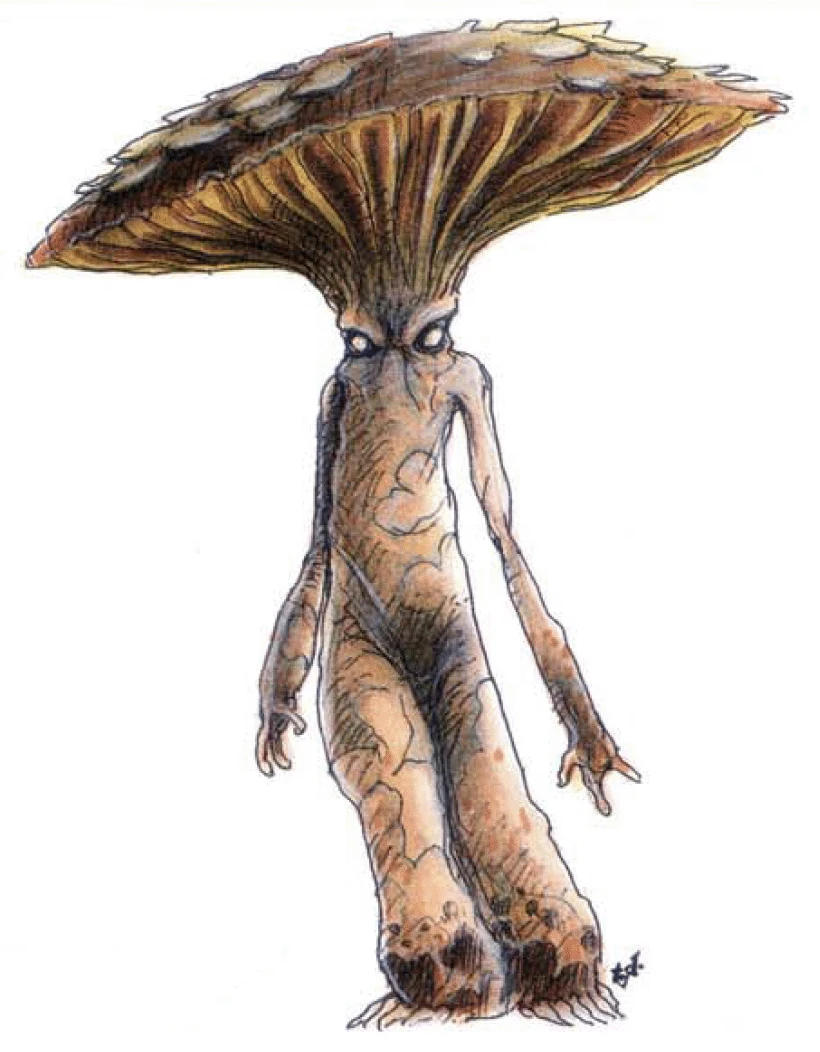
No comments:
Post a Comment